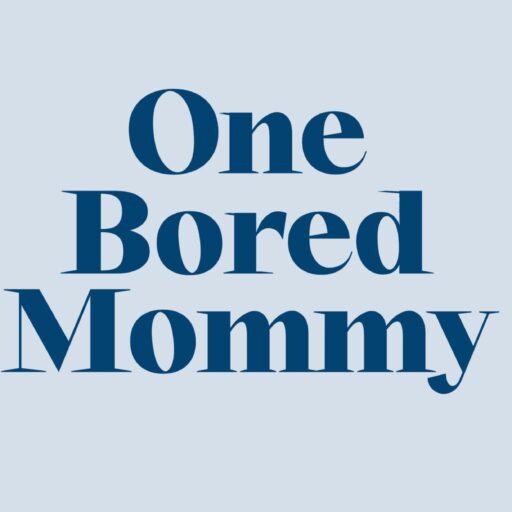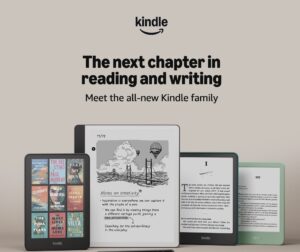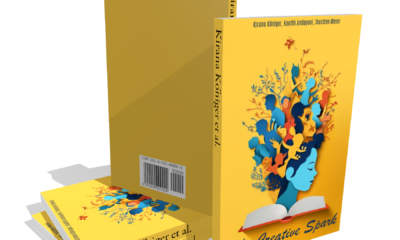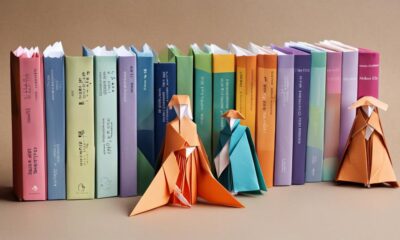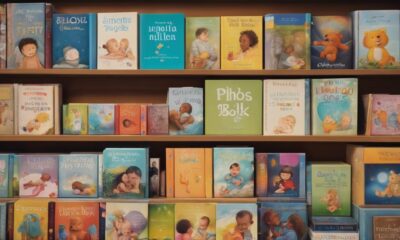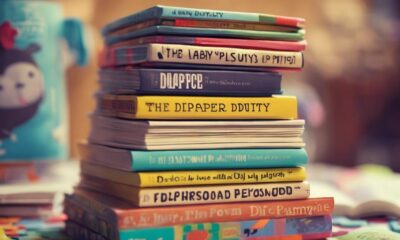Vetted
15 Best Tips on How to Write a Baby Book That Will Capture Hearts
Yearning to craft a baby book that captivates hearts? Discover 15 expert tips to create a mesmerizing tale for little ones and parents alike.

Craft a mesmerizing baby book by prioritizing storytelling mastery to touch the hearts of young readers and parents. Start with a structured plan, engaging format, and creative guidance to spark imagination. Add interactive elements like flaps, textures, and sounds for a hands-on experience. Choose themes aligned with developmental stages, integrating colors, shapes, and emotions for deeper connections. Embrace a positive, captivating writing style using vivid imagery and repetitive elements for lasting impact. Opt for quality illustrations with interactive features for visual stimulation. By focusing on these key tips, you can create a baby book that resonates with hearts and minds.
Key Takeaways
- Develop engaging content aligned with a baby's developmental stage and cognitive abilities.
- Integrate interactive elements like textures, flaps, and sounds for active learning.
- Use colorful, high-quality illustrations to enhance visual stimulation.
- Craft a positive and uplifting tone throughout the book.
- Incorporate sensory details, repetition, and rhyme for an immersive and engaging experience.
Start Writing Your Book Today: Step-by-Step Plan to Write Your Nonfiction Book
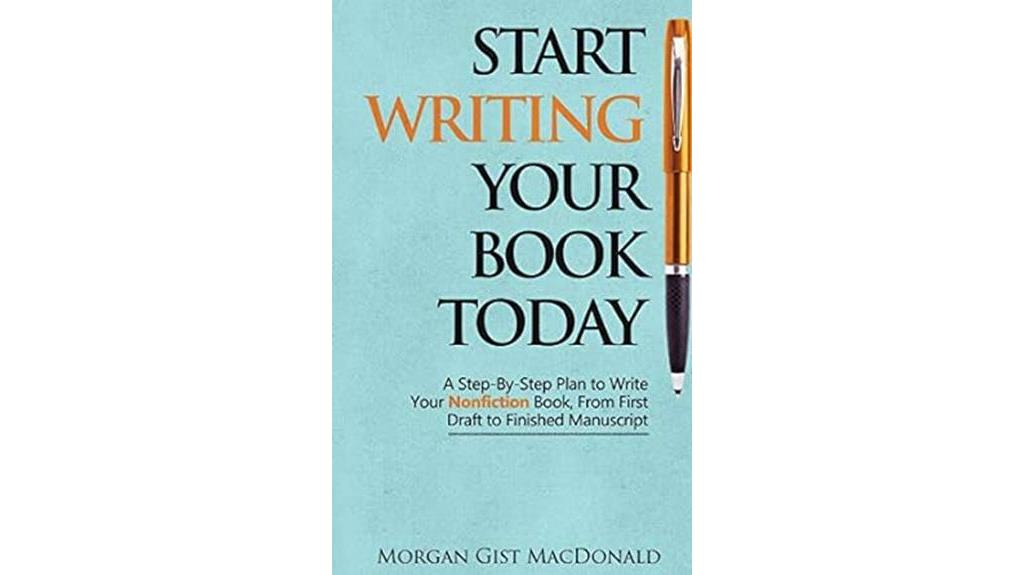
If you're a nonfiction writer seeking a clear roadmap to develop good writing habits and successfully complete your manuscript, 'Start Writing Your Book Today' by Morgan Gist MacDonald is the ideal choice.
This book has garnered positive feedback for its step-by-step approach, actionable steps, and effective writing techniques. As an Editor and Writing Coach, Morgan Gist MacDonald's expertise shines through in the impact her methods have on writing productivity.
The book emphasizes the importance of commitment, establishing a writing routine, and utilizing exercises like free writing. While some readers have critiqued the inclusion of contact information, overall, the book is recommended for its practical tips, easy-to-follow suggestions, and detailed guidance on the writing process.
It serves as a standout resource for nonfiction writers looking to navigate the journey from developing routines to completing a finished manuscript.
Best For: Nonfiction writers seeking a structured approach to developing writing habits and completing their manuscripts efficiently.
Pros:
- Step-by-step guidance for effective writing techniques.
- Emphasis on establishing a writing routine and commitment.
- Valuable resources for developing a clear roadmap from draft to completion.
Cons:
- Mixed reviews regarding the inclusion of contact information.
- Suggestions for updating information for accuracy.
- Minor disappointments noted, despite overall content quality.
How to Write a Story: (Read-Aloud Book, Learn to Read and Write)

For parents and educators seeking a helpful resource to guide young children in developing their writing skills, 'How to Write a Story' is an engaging and educational read-aloud book by Kate Messner and Mark Siegel.
This book follows a young girl's journey through the process of creating a story, from finding inspiration to shaping characters and plots. With its colorful illustrations and step-by-step guidance, 'How to Write a Story' has been well-received for its ability to keep children interested and motivated.
Ideal for preschool and kindergarten-aged kids, this book not only teaches essential writing skills but also fosters creativity and encourages storytelling. Recommended by teachers and parents, 'How to Write a Story' is a valuable tool for children who may need extra support in developing their writing abilities.
Best For: Parents and educators looking for a captivating tool to assist preschool and kindergarten-aged children in developing their writing skills.
Pros:
- Engaging format and colorful illustrations.
- Step-by-step guidance through the writing process.
- Encourages creativity and storytelling in young readers.
Cons:
- May not be as beneficial for older children or advanced writers.
- Limited focus on more advanced writing techniques.
- Some children may need additional support beyond the book's guidance.
How To Write Your First Book: Tips On How To Write Fiction & Non Fiction Books And Build Your Author Platform
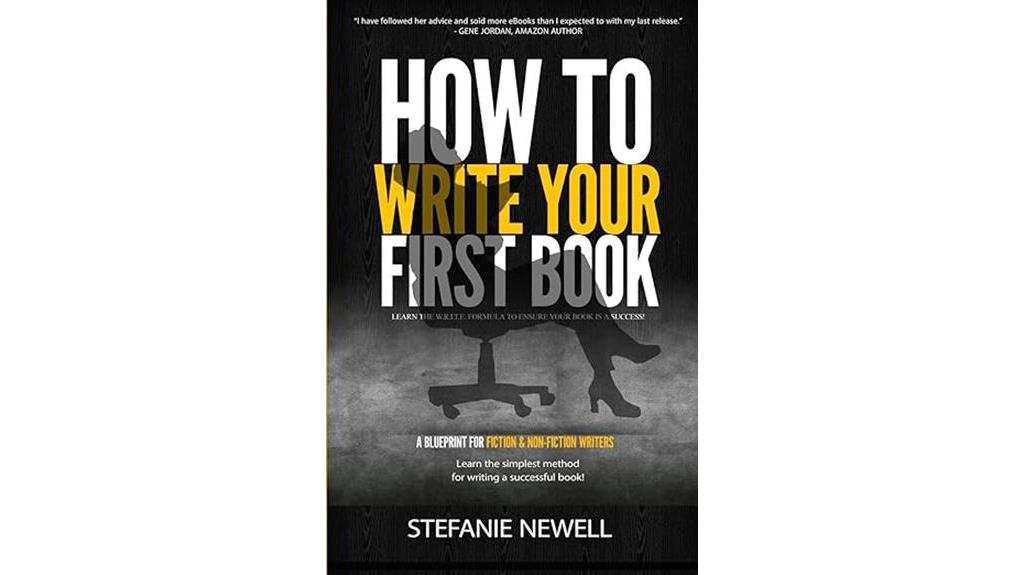
The book 'Tips on Writing a Baby Book' is a valuable resource for aspiring authors seeking guidance on writing their first fiction or non-fiction book and establishing their author platform. It provides practical suggestions for writing, valuable self-publishing advice, and a step-by-step approach that's both honest and inspiring. The book offers straightforward insights and is informative and helpful for beginner writers.
Readers have praised it for being an excellent resource for starting out, with tips on writing fiction and non-fiction books, building an author platform, researching book ideas, and using the W.R.I.T.E method to attract an audience. Additionally, it covers topics such as traditional publishing versus self-publishing, crafting book titles, covers, and descriptions.
This book is highly recommended for new writers looking to overcome writing challenges and kickstart their writing journey.
Best For: Aspiring authors seeking practical guidance on writing their first book and establishing their author platform.
Pros:
- Practical suggestions for writing
- Valuable self-publishing advice
- Step-by-step approach for beginners
Cons:
- Misleading title
- Some may find it lacking in advanced writing techniques
- Limited focus on marketing strategies
How to Write Your Own Life Story: Classic Guide for Nonprofessional Writer

When contemplating how to write my own life story, the traditional manual for nonprofessional writers offers practical advice and step-by-step guidance crucial for embarking on this personal journey.
This book has received positive reviews for its easy-to-understand content and useful tips tailored for individuals interested in recording their life experiences. Readers praise the author's writing style and teaching approach, making it a pleasurable and informative read.
The structured method presented in the book helps in breaking down the challenging task of writing a memoir into manageable steps, promoting motivation and offering valuable insights.
With a focus on practicality and encouragement, this traditional manual serves as a valuable resource for anyone aiming to leave behind a significant record for future generations through the art of storytelling.
Best For: Those who are looking for a comprehensive and practical guide to writing their life story with step-by-step instructions and motivational insights.
Pros:
- Easy-to-understand content and practical advice tailored for nonprofessional writers.
- Structured method for breaking down the process of writing a memoir into manageable steps.
- Positive feedback on the author's writing style and teaching approach, making it an enjoyable and informative read.
Cons:
- Some readers may find the content too basic if they are already experienced in writing memoirs.
- Not much emphasis on advanced writing techniques for seasoned writers.
- Limited focus on digital tools or platforms for organizing and storing life stories.
Punching Babies: a how-to guide (Write Club Series)

This book, 'Punching Babies: a how-to guide (Write Club Series)', offers a detailed breakdown of writing a novel with a focus on plot structure and story elements. It emphasizes the importance of following a formulaic approach to storytelling, providing readers with practical guidance and examples to enhance their writing skills.
Many readers have found this book to be helpful and informative, regardless of their level of experience as writers. The author's unconventional use of language in the title aims to highlight the simplicity of storytelling through a structured method.
By deconstructing a popular movie like 'The Matrix' to illustrate story elements and archetypes, the author effectively conveys key concepts to readers. While some may have reservations about the title, the book's organization, clarity, and practicality in teaching story structure receive praise from readers.
Overall, 'Punching Babies' is recommended for aspiring writers seeking to improve their storytelling abilities.
Best For: Writers at all levels seeking practical guidance on plot structure and story elements.
Pros:
- Detailed breakdown of writing a novel with emphasis on formulaic storytelling.
- Practical information and examples provided for easy understanding.
- Helpful and informative for writers looking to enhance their storytelling skills.
Cons:
- Some readers may find the title off-putting.
- Suggestions for improved organization, including a fully mapped-out table for better clarity, have been made.
- May not appeal to those who prefer a more traditional approach to storytelling.
How to Write Your First Book: Publish the Book You've Always Dreamed of in One Month or Less as a Beginner
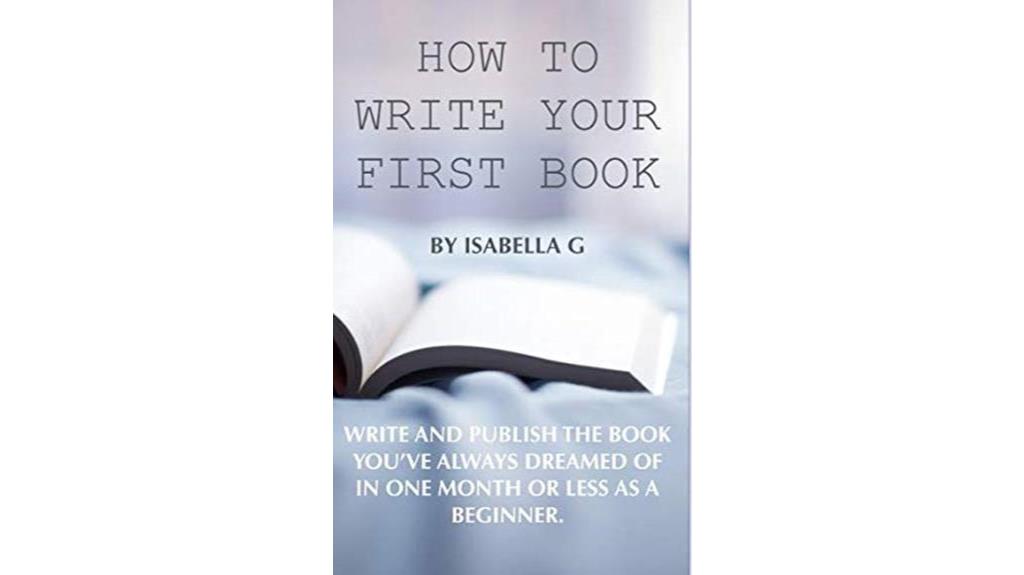
For beginners aspiring to publish their dream book quickly, 'Tips on Writing a Baby Book' offers valuable guidance and inspiration. This resource provides a straightforward and informative approach to writing and publishing, making it easy to understand and implement.
It encourages and motivates aspiring authors, giving them the push they need to start their writing journey. With practical advice for self-publishing on Amazon Kindle, this book serves as a useful guide for finding freelance editors and artists.
It lays out basic steps for publishing on Amazon Kindle and offers step-by-step instructions for proceeding through the publishing process. By emphasizing efficiency in writing and publishing, this book equips beginners with techniques to bring their dream book to life in one month or less.
Best For: Beginners looking to quickly publish their first book and seeking guidance on writing and self-publishing.
Pros:
- Provides straightforward and informative guidance on writing and publishing.
- Encourages and motivates aspiring authors to start their writing journey.
- Offers practical advice for self-publishing on Amazon Kindle and finding freelance editors and artists.
Cons:
- May focus more on speed of publishing rather than depth of content.
- Limited focus on traditional publishing methods.
- Some readers may prefer more in-depth writing techniques and strategies.
The Book You Were Born to Write: Everything You Need to (Finally) Get Your Wisdom onto the Page and into the World
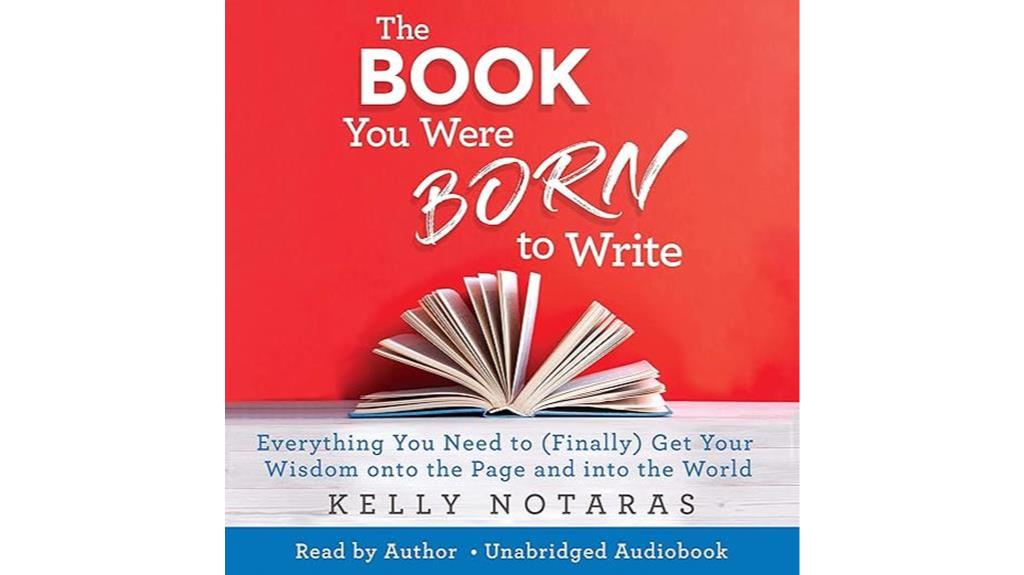
If you're an aspiring author seeking practical guidance to bring your message into the world through writing, 'The Book You Were Born to Write: Everything You Need to (Finally) Get Your Wisdom onto the Page and into the World' by Kelly Notaras is the essential resource for you.
This book provides thorough advice, tips, and resources for writers looking to make an impact with their words. Notaras emphasizes the importance of marketing alongside writing, offering specific strategies for success before diving into the writing process. By focusing on crafting a clear and impactful message, aspiring authors can navigate the publishing industry with more confidence.
Notaras acts as a coach, sharing personal experiences and insights to guide writers through their journey. Readers have praised the book for its practicality and engaging nature, making it a valuable tool for those looking to share their wisdom through writing.
Best For: Aspiring authors seeking comprehensive guidance and practical advice to effectively share their wisdom through writing.
Pros:
- Offers practical advice, tips, and resources for writers.
- Emphasizes the importance of marketing alongside writing.
- Provides specific strategies for success and crafting a clear message.
Cons:
- Some readers express concerns about the high costs associated with publishing experts.
- Issues like expensive book cover design need to be addressed.
- Despite its valuable information, some readers may find the book pricey.
How To Write Non-Fiction: Turn Your Knowledge Into Words
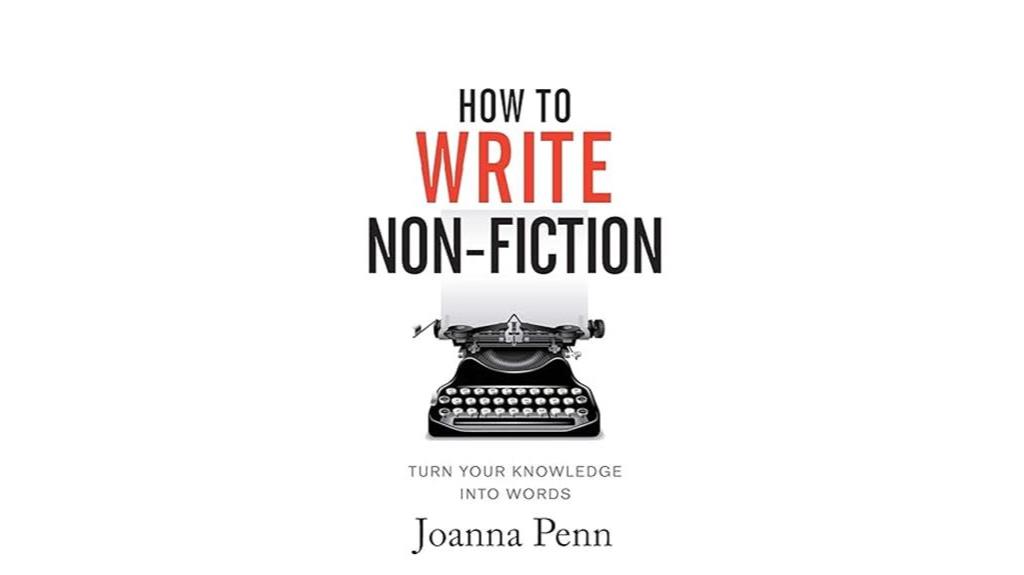
When delving into the process of writing non-fiction, aspiring authors can benefit greatly from the practical insights and clear strategies presented in Joanna Penn's detailed guide.
Penn's book provides clear steps for transforming your knowledge into a compelling non-fiction book. Each chapter ends with powerful questions that prompt deeper thinking and planning.
By sharing her personal experiences, Penn makes the content relatable and engaging. Additionally, the book offers valuable resources and actionable strategies to guide writers through every stage of their non-fiction project.
While some readers critique the author for excessive self-promotion, many appreciate her efforts to foster creativity. Overall, this book is recommended for both new and experienced authors looking to craft informative, interesting, and inspiring non-fiction works.
Best For: Aspiring and experienced authors seeking a comprehensive guide to writing engaging and informative non-fiction books.
Pros:
- Provides clear steps for writing a non-fiction book.
- Includes powerful questions to prompt deeper thinking and planning.
- Offers valuable resources and actionable strategies for every stage of the writing process.
Cons:
- Excessive self-promotion of the author's website and products may be off-putting to some readers.
- Frequent references to the author's website could be seen as annoying.
- Some readers may find the author's marketing approach distracting from the content of the book.
How to Write a Childrens Book and Get It Published
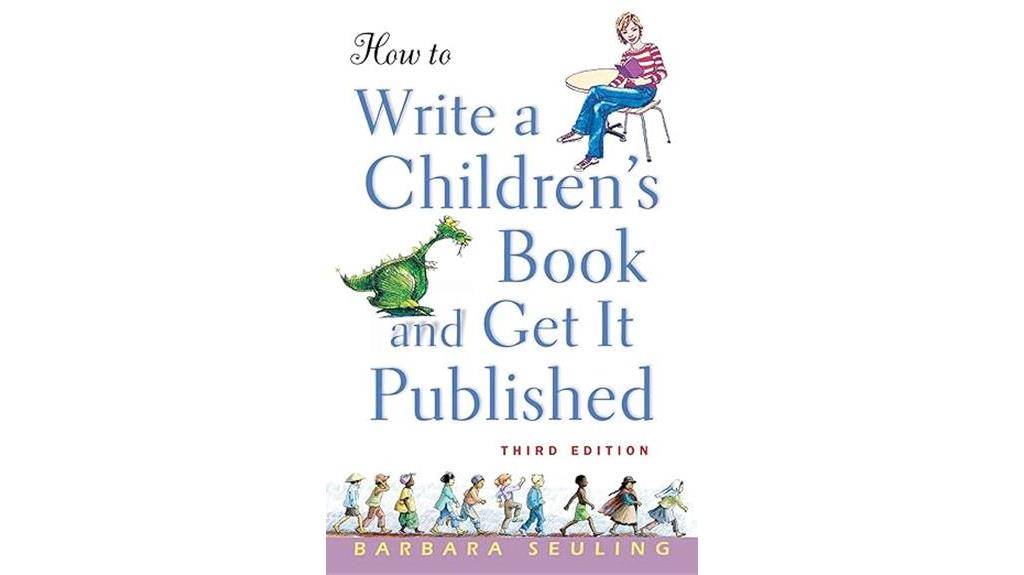
The book 'Tips on Writing a Baby Book' is an excellent resource for aspiring children's book writers looking to understand the process of writing and publishing in the genre.
When it comes to writing a children's book and getting it published, there are essential steps to follow. Developing engaging story ideas, honing your writing skills, and catering to different age groups are vital aspects to take into account.
It's important to look at your work critically, submit proposals and manuscripts, and find the right publisher for your story. Understanding contracts, working with agents, and joining the writing community can further enhance your chances of success.
By mastering these elements, you can increase your chances of creating an interesting children's book that resonates with young readers and getting it published in the competitive world of children's literature.
Best For: Aspiring children's book writers seeking guidance on writing and publishing in the genre.
Pros:
- Comprehensive guidance on developing story ideas and improving writing skills.
- Valuable information on submitting proposals, finding the right publisher, and working with agents.
- Updated resources on major developments in book publishing and children's literature.
Cons:
- May lack in-depth coverage on specific genres within children's literature.
- Limited discussion on marketing strategies for promoting children's books.
- Some readers may prefer more detailed examples or case studies for better understanding.
How To Self-Publish A Children's Book

For aspiring authors looking to self-publish their children's books, 'Tips on Writing a Baby Book' is an invaluable resource offering step-by-step guidance and essential tools. This book provides a detailed guide on writing and self-publishing children's books, including templates, tools, and resources to support authors through the process.
Readers appreciate the valuable information, confidence-boosting tips, and the supportive approach taken by the author, Eevi Jones. Additionally, Eevi Jones supplements the book with a YouTube channel where she elaborates on the content, offering further guidance and building a supportive community for children's book self-publishers.
Testimonials from readers highlight the book's clarity, ease of use, and effectiveness in guiding authors through the publishing journey. With international acclaim for its comprehensive advice on collaboration, marketing strategies, and empowering authors, 'Tips on Writing a Baby Book' equips beginners with the tools to successfully write, illustrate, publish, and market their children's books.
Best For: Aspiring authors looking to self-publish their children's books with comprehensive guidance and support.
Pros:
- Detailed step-by-step guide for writing and self-publishing children's books.
- Valuable resources, templates, and tools provided to support authors.
- Author's supportive and encouraging approach boosts confidence and motivation.
Cons:
- Limited information on advanced self-publishing strategies.
- May require additional research for specific publishing platforms.
- Some readers may prefer more in-depth tips on marketing strategies.
How to Write a Poem
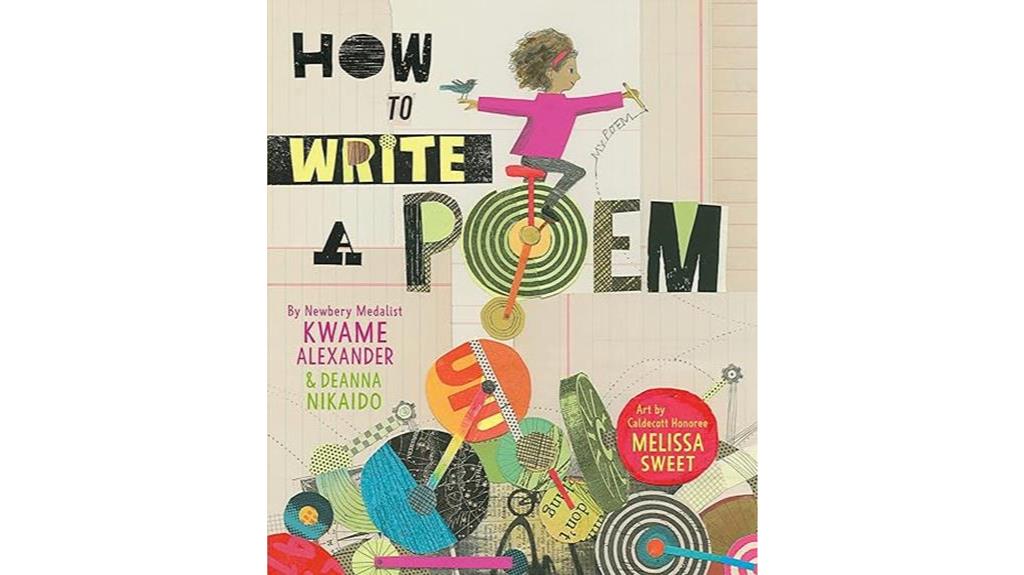
To truly understand the essence of crafting poetry, one must explore the pages of 'How to Write a Poem' by Kwame Alexander and L. Deanna Nikaido, a delightful guide that infuses creativity into readers of all ages.
This book, published by Quill Tree Books on April 4, 2023, serves as a playful tribute to poetry writing, inspiring individuals from toddlers to teens to immerse into the art of poetic expression.
With illustrations by Melissa Sweet that evoke joy and whimsy, 'How to Write a Poem' emphasizes finding inspiration in everyday life and paying attention to details. It encourages a fun and creative approach to writing poetry, incorporating shapes, colors, and sounds to spark imagination.
While some may find the abstract art challenging, the overall feedback celebrates the book's ability to ignite joy and inspire poetic expression in readers.
Best For: Individuals seeking a creative and inspiring guide to writing poetry that celebrates the magic of language and imagination.
Pros:
- Engaging content that sparks imagination and poetic expression.
- Playful and whimsical illustrations that complement the poetic journey.
- Encourages a fun and creative approach to writing poetry, incorporating shapes, colors, and sounds.
Cons:
- Some may find the abstract art challenging.
- Not suitable for individuals who prefer traditional or structured poetry guides.
- Limited focus on specific poetic forms or techniques for advanced writers.
How To Write A Childrens Fiction Book

If you're a novice writer exploring the world of children's fiction, Karen Cioffi's 'How to Write a Children's Fiction Book' is a must-have resource for honing your craft. This book, with its subtitle 'Your guide to Writing a Children's Book', offers expert guidance from ghostwriting veteran Karen Cioffi.
It emphasizes the importance of seeking advice from experts when delving into a new genre, making it a valuable tool for aspiring children's authors. By highlighting basic genre differences in children's books, providing tips to avoid common pitfalls, and stressing the need to refine writing techniques specific to children's literature, Cioffi's book equips writers with essential skills.
Testimonials from those who found the book helpful underscore the significance of continuous learning and improvement in writing for children, making it a thorough guide for aspiring authors.
Best For: Writers new to the children's fiction genre seeking expert guidance and comprehensive advice on writing children's books.
Pros:
- Expert guidance from ghostwriting veteran Karen Cioffi.
- Emphasizes the importance of refining writing techniques specific to children's literature.
- Provides resources, checklists, and DIY assignments to aid in completing a children's book project.
Cons:
- May not cover advanced or highly specialized topics in children's fiction writing.
- Some readers may find the writing tips to be basic or common knowledge.
- Limited focus on marketing and promoting children's books after completion.
How to Write a Children's Book

When delving into the world of writing children's books, aspiring authors will find 'How to Write a Children's Book' to be a valuable and all-encompassing resource. This book offers clear and concise guidance on various aspects of writing and publishing for kids. From outlining and plotting to character development, conflict, revision, and story structure, it covers all the essentials.
Readers highly recommend this book for anyone interested in writing children's books, praising its practicality and usefulness. With insights on target audience, idea formation, writing styles, and different types of writing, it provides a thorough understanding of the craft.
Divided into chapters with step-by-step action plans and writing exercises, it guides beginners in the process. Whether you're into picture books or young adult novels, this book encourages continuous learning and improvement in your writing journey.
Best For: Aspiring children's book authors seeking clear and practical guidance on writing and publishing for kids.
Pros:
- Comprehensive coverage of writing and publishing aspects for children's books.
- Step-by-step action plans and writing exercises for hands-on learning.
- Insights on target audience, idea formation, and different writing styles.
Cons:
- May lack in-depth coverage of specific genres within children's literature.
- Limited focus on marketing and promotion strategies for children's book authors.
- Additional resources may be needed for further exploration of advanced writing techniques.
How to Write a Book Report (Explorer Junior Library: How to Write)

For parents seeking guidance on creating a meaningful keepsake for their newborn, the book 'How to Write a Book Report' from the Explorer Junior Library offers valuable insights on expressing opinions about children's literature effectively.
Book reports serve as a vital tool for young readers to articulate their thoughts on the books they've read. This guide focuses on honing the skills needed to extract essential details from a text and craft a well-structured book report.
By engaging with the exercises provided in this resource, children can enhance their ability to analyze and communicate their perspectives on various literary works. Through this process, young readers develop critical thinking skills and learn to appreciate and evaluate literature in a more inclusive manner.
Best For: Parents of young readers looking to enhance their children's ability to express opinions on children's literature effectively.
Pros:
- Provides valuable insights on expressing opinions about children's literature
- Focuses on honing skills to extract essential details from a text
- Helps in crafting a well-structured book report
Cons:
- May require additional guidance or explanation for younger children
- Exercises may need adult supervision for full comprehension
- Limited focus specifically on children's literature
How to Write a Book for Beginners
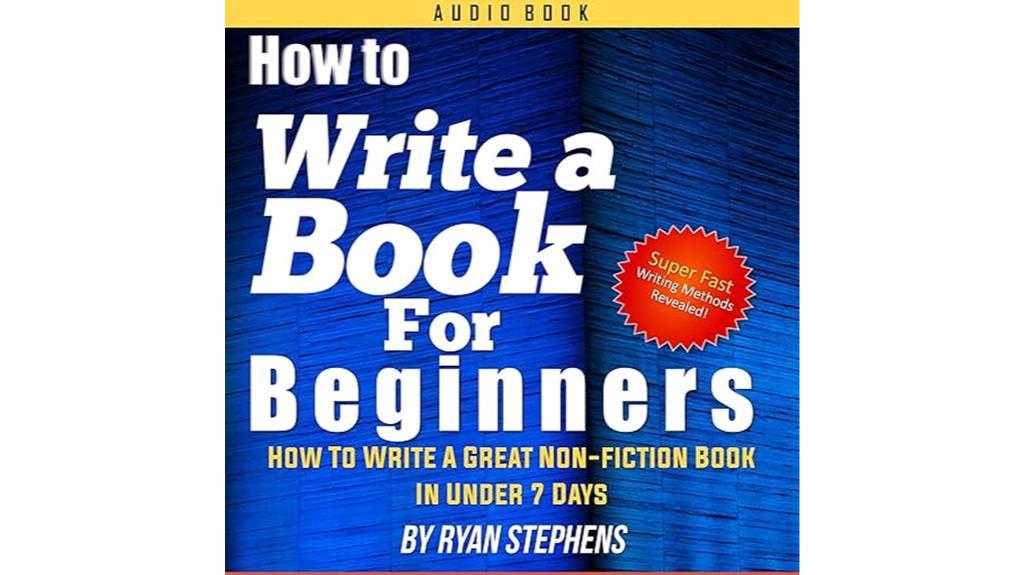
The 'Tips on Writing a Baby Book' is an invaluable resource tailored specifically for novice writers looking to craft their first book with guidance and practical advice.
As a beginner writer, diving into the world of book writing can feel overwhelming, but this book aims to simplify the process. It offers useful information on outlining, which is essential for organizing your thoughts and creating a solid structure for your book.
Additionally, the book provides insights into non-fiction writing, giving you a starting point to explore this genre. While some readers have pointed out spelling errors and typos in the book, the positive reviews highlight the effectiveness of the tips provided.
By following the writing techniques and tips outlined in this book, you can enhance your writing skills, develop good habits, and work towards becoming a more efficient writer.
Best For: Novice writers seeking practical guidance and advice on crafting their first book.
Pros:
- Provides valuable information on outlining and non-fiction writing.
- Offers insights into writing techniques to enhance skills.
- Helps in developing good writing habits for efficiency.
Cons:
- Some readers noted spelling errors and typos.
- Formatting and grammar inconsistencies may be present.
- Certain ideas in the book may be considered amateurish or outdated.
Factors to Consider When Choosing How to Write a Baby Book

When deciding how to write a baby book, it's important to ponder factors like the content you want to include, tips for your writing style, and the significance of illustrations.
Choosing age-appropriate topics and using engaging storytelling techniques can also impact the overall success of your book.
Choosing Book Content
When selecting the content for a baby book, considering the age range of the intended audience is vital to guarantee engagement and educational value.
It's crucial to develop content that isn't only age-appropriate but also captivating for young minds.
Focus on integrating interactive elements like textures, flaps, or sounds to enhance the reading experience and keep the little ones interested.
Additionally, choose themes or topics that resonate with parents, as this can promote bonding moments during storytime.
Quality illustrations and durable materials should also be prioritized to make sure a visually appealing and long-lasting book.
Writing Style Tips
Considering the young audience's perspective, crafting a conversational and engaging writing style is vital when creating a baby book. To connect with readers on a personal level, it's crucial to use sensory details and descriptive language that paint vivid images of the baby's experiences.
Maintaining a positive and uplifting tone throughout the book can inspire parents and create a warm reading atmosphere. Since the target audience consists of parents and caregivers, using simple language and short sentences will help guarantee the content is easily understood.
Additionally, incorporating interactive elements like prompts, questions, and spaces for personal notes can enhance reader engagement and encourage reflection. By following these writing style tips, your baby book can captivate hearts and create lasting memories for both parents and children.
Illustration Importance
To effectively engage young readers and enhance their learning experience, careful consideration of illustration importance is key when creating a baby book. Colorful and engaging illustrations play a crucial role in capturing a baby's attention and fostering visual stimulation. Opt for bright colors, simple shapes, and high contrast images to create visually appealing pages that support the text and enhance the storyline. These illustrations help babies make connections between words and images, aiding in cognitive development and language acquisition.
Incorporating interactive features like lift-the-flap, touch-and-feel, or peek-a-boo elements can further enhance the sensory experience for babies, making the reading process more engaging and interactive.
When selecting illustrations for a baby book, make sure they're age-appropriate and of high quality to provide an enriching early childhood learning experience. Remember, well-crafted illustrations not only make the book visually appealing but also serve as valuable tools for a baby's development.
Age-Appropriate Topics
As I plan a baby book, I carefully consider age-appropriate themes that align with a baby's developmental stage and cognitive abilities. It's crucial to choose topics that match a baby's evolving interests, such as basic concepts like colors, shapes, animals, and daily routines. These subjects not only grab their attention but also assist in their cognitive growth.
Additionally, focusing on themes connected to sensory exploration, emotions, and relationships can help babies connect with the content on a deeper level.
To ensure the baby book is captivating, integrating interactive elements like various textures, flaps, and sounds is crucial. These features not only excite their senses but also encourage active learning. Including recurring patterns and rhymes can further boost language development and cognitive skills in babies, making the reading experience more enjoyable and educational.
Furthermore, visually engaging content with vibrant colors, high contrast images, and straightforward illustrations can captivate a baby's attention and maintain their interest throughout the book. By thoughtfully selecting age-appropriate themes and interactive features, a baby book can become a cherished learning tool for both babies and parents alike.
Engaging Storytelling Techniques
Incorporating sensory details like touch, smell, and sound enhances the storytelling experience in a baby book, engaging young readers and stimulating their developing senses. By describing how characters feel, the scents in the air, or the noises they hear, you can make the story come alive for babies.
Repetition and rhyme are also effective tools to keep babies engaged, helping with language development and memory. Simple and clear storylines paired with vibrant illustrations can captivate their attention and make the reading experience enjoyable.
Adding interactive elements like lift-the-flap or touch-and-feel features not only makes the book tactile but also encourages babies to explore and interact with the story. Using onomatopoeia and sound words further enhances the narrative, bringing it to life and engaging babies' auditory senses.
When creating a baby book, remember to craft a multisensory experience that delights and engages all their senses, making reading a joyful and immersive activity.
Frequently Asked Questions
How Do I Choose the Perfect Theme for My Baby Book?
When selecting a theme for my baby book, I consider what resonates with me and reflects the essence of my child. I aim for something timeless, personal, and enchanting to guarantee the story will be cherished.
What Are Some Creative Ways to Personalize a Baby Book?
Crafting a baby book can be a creative journey. Personalizing it with handprints, family tree illustrations, and heartfelt letters adds a unique touch. Use colors, textures, and quotes to make each page a treasure trove of memories.
Can I Include Interactive Elements in My Baby Book?
Yes, I can include interactive elements in my baby book. Adding touch-and-feel textures, flaps to lift, or pockets for keepsakes can engage both the child and the reader, creating a more memorable and interactive reading experience.
Is It Important to Include Family Traditions in a Baby Book?
Surprisingly, I used to think family traditions in a baby book were just extra pages. Now, I realize they're the heart. They add depth, connection, and a beautiful legacy for little ones.
How Can I Ensure My Baby Book Stands the Test of Time for Future Generations?
I'll safeguard timeless memories in my baby book by capturing unique moments, sharing personal stories, including family traditions, using high-quality materials, and organizing it chronologically. Combining creativity with authenticity guarantees its enduring legacy.
Conclusion
To sum up, writing a baby book that captures hearts requires dedication, creativity, and attention to detail.
By following the tips outlined in this article, you can create a timeless and cherished book that will be treasured for years to come.
Remember to stay true to your voice, connect with your audience, and infuse your writing with passion and authenticity.
Happy writing!
Vetted
Book Review: “The Creative Spark: Unleashing Your Inner Artist”
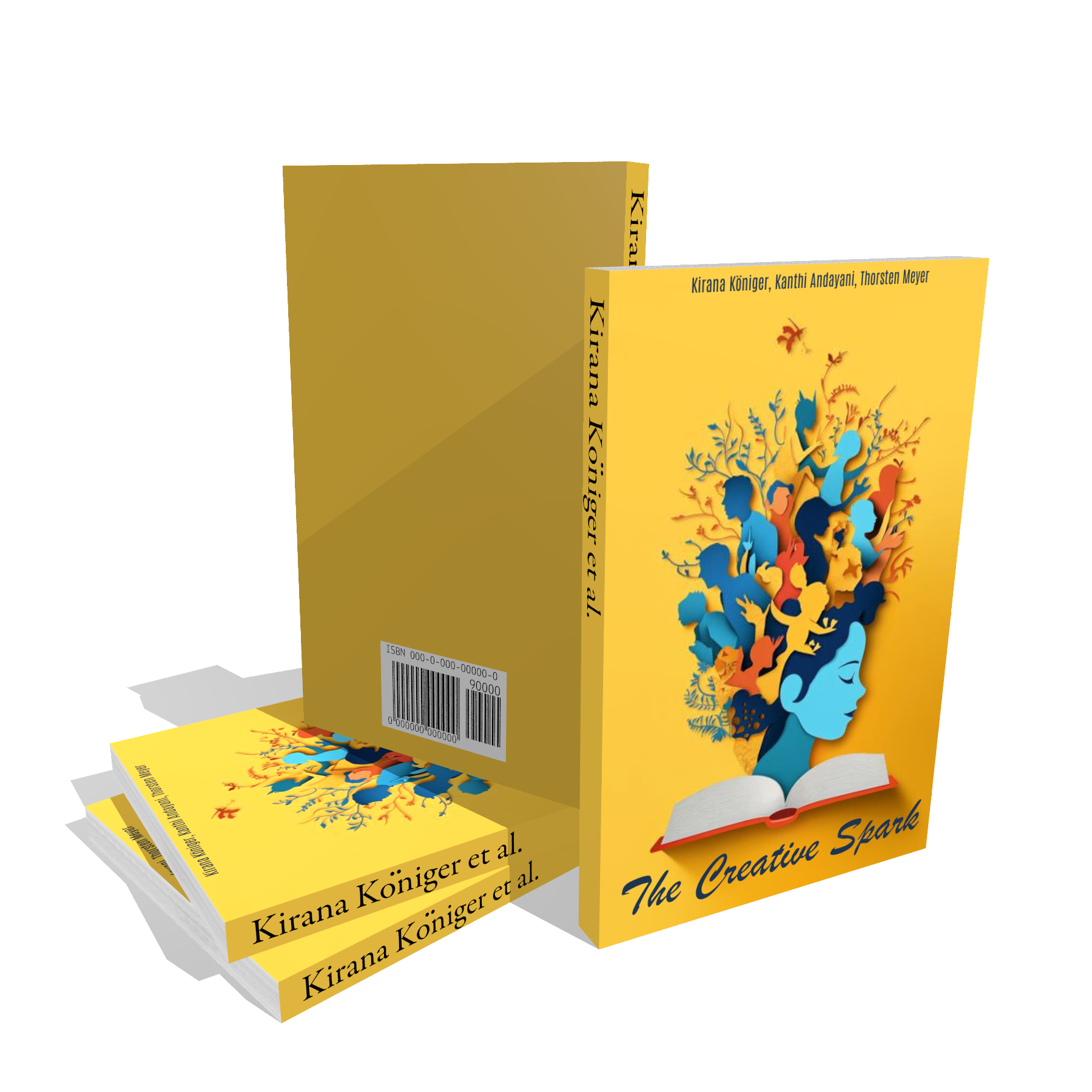
Reviving Creativity in the Digital Age
In an era where digital distractions often dim our creative instincts, “The Creative Spark: Unleashing Your Inner Artist” arrives as a refreshing and vital resource. Authored by Kirana Königer, Kanthi Andayani, and Thorsten Meyer, this book offers a comprehensive approach to rekindling the creative spirit within us all.
A Rich Tapestry of Global Creative Insights
The authors draw from their diverse backgrounds, encompassing Indonesian heritage, European influences, and global experiences, to offer a rich array of cultural perspectives. This diversity is more than a backdrop; it forms the essence of their belief that creativity is a universal language, bridging cultures and continents.
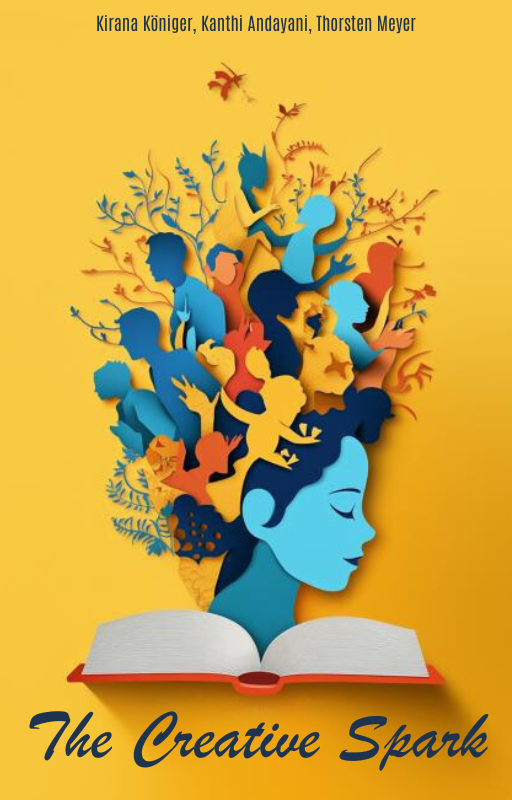
Expanding the Concept of Creativity
“The Creative Spark” challenges traditional views of creativity, pushing beyond the confines of the arts. The authors make a compelling case that creative thinking is an essential life skill, valuable in problem-solving, personal development, and professional success in any field.
The Science of Creativity
Rooted in scientific research, the book explores:
- The neurological underpinnings of creativity
- How various brain regions contribute to creative thought
- The role of neuroplasticity in nurturing creative abilities
- The impact of environment and lifestyle on creative potential
Practical Exercises for Creative Growth
Each chapter provides a wealth of exercises aimed at stimulating creativity across different disciplines:
- Writing prompts to inspire authors
- Visual challenges for artists and designers
- Culinary experiments for those passionate about cooking
- Mindfulness practices to enhance creative awareness
- Cross-disciplinary projects that combine multiple forms of art
Overcoming Creative Challenges
The book offers practical advice for navigating the common hurdles of the creative process, including:
- Breaking through creative blocks and stagnation
- Overcoming self-doubt and imposter syndrome
- Managing perfectionism and the fear of failure
- Balancing creative endeavors with everyday responsibilities
Creativity in the Digital World
The authors thoughtfully examine the intersection of technology and creativity, discussing:
- How digital tools can enhance the creative process
- Strategies for balancing digital and analog creative practices
- Leveraging social media to share and promote creative work
- Ethical considerations in the era of AI-generated art
A Personal Journey of Creative Discovery
The book is enriched with personal stories from the authors’ own creative journeys, adding a relatable and human element to the discussion. Readers are encouraged to embark on their own paths of creative discovery, guided by reflective questions and exercises designed to uncover their unique creative strengths.
Critical Evaluation
Strengths:
- A broad approach that transcends traditional artistic boundaries
- A multicultural perspective offering a wide array of global insights
- A strong foundation in scientific research, balanced with practical application
- An inclusive tone that makes creativity accessible to everyone
Considerations:
- The wide range of topics might be overwhelming for some readers
- Certain cultural references may resonate differently with various audiences
- Some advanced readers might find familiar concepts, though presented with new insights
Conclusion: A Blueprint for Creative Living
“The Creative Spark: Unleashing Your Inner Artist” is more than just a guide to artistic expression—it’s a framework for living a more imaginative and fulfilling life. By redefining creativity as a core human trait, the authors have crafted a work that has the potential to transform not just how readers approach art, but how they approach life itself.
Rating: 4.85/5 stars
Highly recommended for its inclusive approach, scientific grounding, and transformative potential, “The Creative Spark” is a standout guide for anyone seeking to reignite their creative energy and live a more inspired life.
Vetted
15 Best Parenting Books for Discipline Every Parent Should Read
Peruse top parenting books for discipline, such as 'No-Drama Discipline' and 'The Whole-Brain Child,' for valuable insights and strategies to enhance your parenting journey.

When it comes to discipline and nurturing your child's developing mind, consider exploring the following top parenting books for valuable insights and practical strategies: "No-Drama Discipline," "The Whole-Brain Child," "1-2-3 Magic," "Grace Based Discipline," "Toddler Discipline 101," "Positive Discipline Parenting Tools," and "Positive Discipline for Kids." These books offer a range of approaches, from whole-brain methods to gentle discipline steps for toddlers. By incorporating these resources into your parenting journey, you can enhance your understanding of effective discipline techniques and strengthen your bond with your child. Each book provides unique perspectives on fostering positive behavior and improving communication in your family dynamic.
Key Takeaways
- Practical tools for nurturing a child's mind in a drama-free manner.
- Valuable insights on discipline methods challenging traditional approaches.
- Effective strategies for improving parent-child interactions based on brain development.
- Simple 3-step discipline method emphasizing consistency and composure.
- Encourages positive behavior changes through emotional connection and communication.
No-Drama Discipline: The Whole-Brain Way to Calm the Chaos and Nurture Your Child's Developing Mind
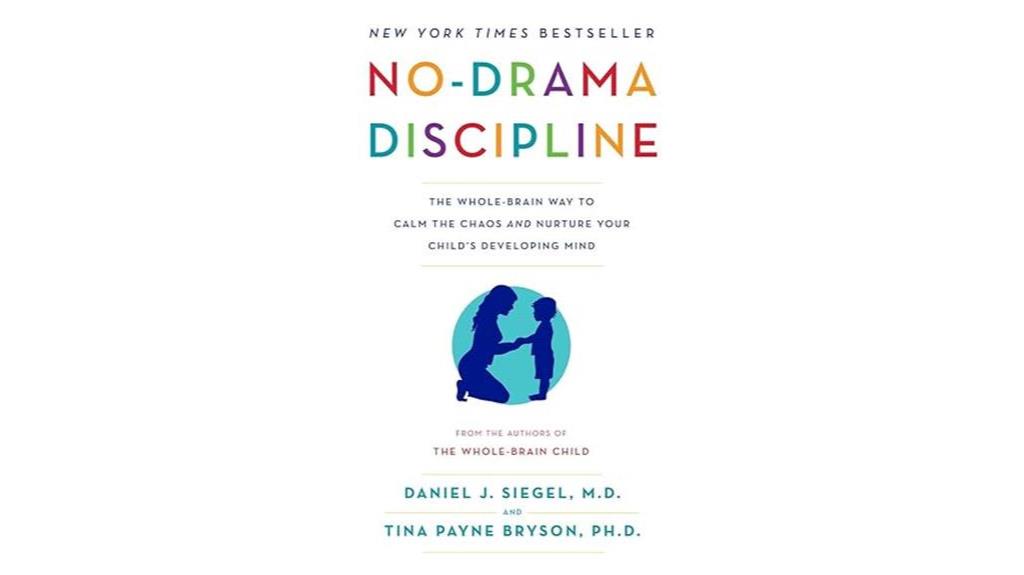
For parents seeking a transformative approach to discipline, 'No-Drama Discipline' offers practical tools and valuable insights into nurturing their child's developing mind. This highly recommended book provides a fresh perspective on discipline methods by emphasizing the importance of understanding a child's developing brain.
Readers have found it transformative, challenging existing mindsets and honing parenting skills. Personal stories highlight its positive impact, reducing drama in parenting and guiding children effectively. The book is praised for its universal appeal, with readers from various backgrounds appreciating its insights and strategies.
It serves as a valuable parenting manual, offering practical tips on discipline and child development. Parents facing challenges in managing their child's behavior particularly benefit from the strategies presented in 'No-Drama Discipline'.
Best For: Parents and caregivers seeking a transformative and practical approach to discipline and child development.
Pros:
- Offers practical tools and valuable insights for nurturing a child's developing mind.
- Challenges existing mindsets and provides a fresh perspective on discipline methods.
- Universal appeal with practical tips appreciated by readers from various backgrounds.
Cons:
- May require consistent practice and effort to fully implement the strategies.
- Some readers may find the approach different from traditional parenting methods.
- Not all techniques may work for every child or family dynamic.
The Whole-Brain Child: 12 Revolutionary Strategies to Nurture Your Child's Developing Mind
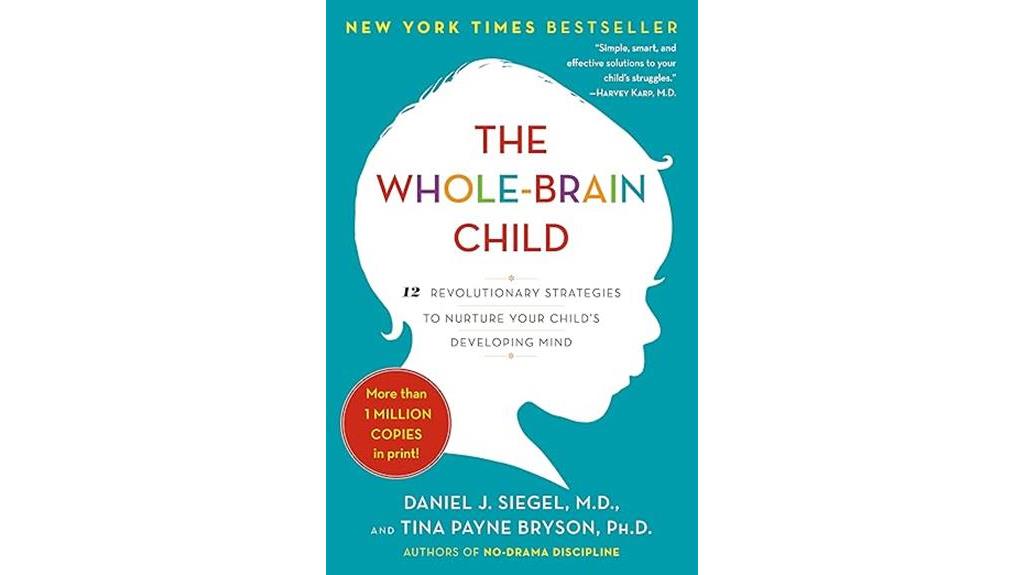
Many parents have found 'The Whole-Brain Child: 12 Revolutionary Strategies to Nurture Your Child's Developing Mind' to be a transformative guide for understanding and improving their parenting techniques. This book offers valuable insights into the workings of a child's brain, emotions, and behavior.
Parents have reported positive changes in how they interact with their children after implementing the practical techniques outlined in the book. Pediatric therapists and professionals recommend this resource for its approachable language and effective strategies. It breaks down complex neurobiology and cognitive psychology concepts into easily understandable information for all parents.
By emphasizing the importance of direct connection and understanding the reasons behind behaviors, 'The Whole-Brain Child' provides a solid foundation for nurturing a child's developing mind.
Best For: Parents seeking practical strategies to positively impact their parenting approach and better understand their child's developing mind.
Pros:
- Provides valuable insights into child brain development and behavior.
- Offers practical and effective techniques for improving parent-child interactions.
- Recommended by pediatric therapists and professionals for its approachable language and content.
Cons:
- Some readers may find the book more tailored to certain demographics.
- Implementing strategies may require significant effort and mindset shifts.
- Not all challenging situations or children with specific needs may be fully addressed.
1-2-3 Magic: Gentle 3-Step Child & Toddler Discipline for Calm, Effective, and Happy Parenting
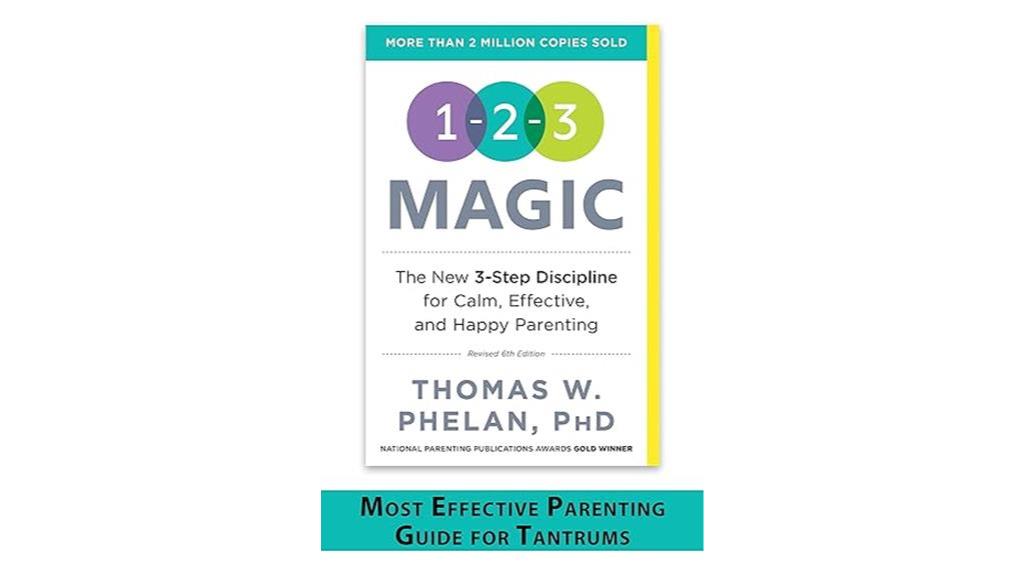
The 'Parenting Books for Discipline' are best suited for parents seeking a gentle and effective approach to managing child behavior and promoting calm, happy parenting. -3 Magic offers a simple yet powerful 3-step method that has garnered praise from parents who've found success in improving their children's behavior.
With an emphasis on consistency and staying composed as a parent, the book provides real-life scenarios and practical solutions to common discipline challenges. It's particularly remarkable for its adaptability to diverse parenting situations, including parents of children with special needs like ADHD or autism.
By encouraging customization to fit individual family dynamics and offering strategies that are easy to understand and implement, -3 Magic has proven to be a valuable resource for parents looking to create a harmonious and effective parenting environment.
Best For: Parents seeking a gentle and effective approach to managing child behavior and promoting calm, happy parenting.
Pros:
- Offers a simple yet powerful 3-step method that has received praise from parents for its effectiveness.
- Emphasizes consistency and composure for parents, providing real-life scenarios and practical solutions.
- Adaptable to diverse parenting situations, including children with special needs, and encourages customization for individual family dynamics.
Cons:
- Requires parents to stay consistent and composed, which may be challenging in certain situations.
- Some parents may find it difficult to implement the method effectively across all age groups within the family.
- Not a one-size-fits-all solution, may require additional adjustments for specific family dynamics.
Grace Based Discipline: How to Be at Your Best When Your Kids Are at Their Worst

Grace Based Discipline: How to Be at Your Best When Your Kids Are at Their Worst provides practical and gospel-centered guidance for parents seeking a balanced approach to discipline. This book, written by a relatable author, offers invigorating parenting advice with personal anecdotes that resonate with readers.
It emphasizes practical techniques for establishing family rules, tailored consequences for misbehavior, and addressing deeper issues behind children's actions. The balanced view on spanking and the distinction between discipline and punishment cater to various parenting styles.
By focusing on building a strong foundation in children and strengthening faith, this book helps parents improve discipline strategies. While some readers desire more practical skills, the book's impact on parenting and faith is widely appreciated in communities and groups seeking a grace-based approach to discipline.
Best For: Parents looking for a balanced and gospel-centered approach to discipline that emphasizes practical techniques and strengthening faith.
Pros:
- Practical and relatable parenting advice with personal anecdotes.
- Tailored consequences for misbehavior based on individual factors.
- Emphasis on addressing deeper issues behind children's actions.
Cons:
- Some readers may desire more practical skills and strategies.
- Limited Christian perspective may not fully satisfy all readers seeking a thorough faith-based approach.
- The book's content may not align with all parenting styles or beliefs.
Toddler Discipline 101: Positive Parenting Steps to End Power Struggles, Overcome Tantrums and Calmly Get Your Kids to Listen
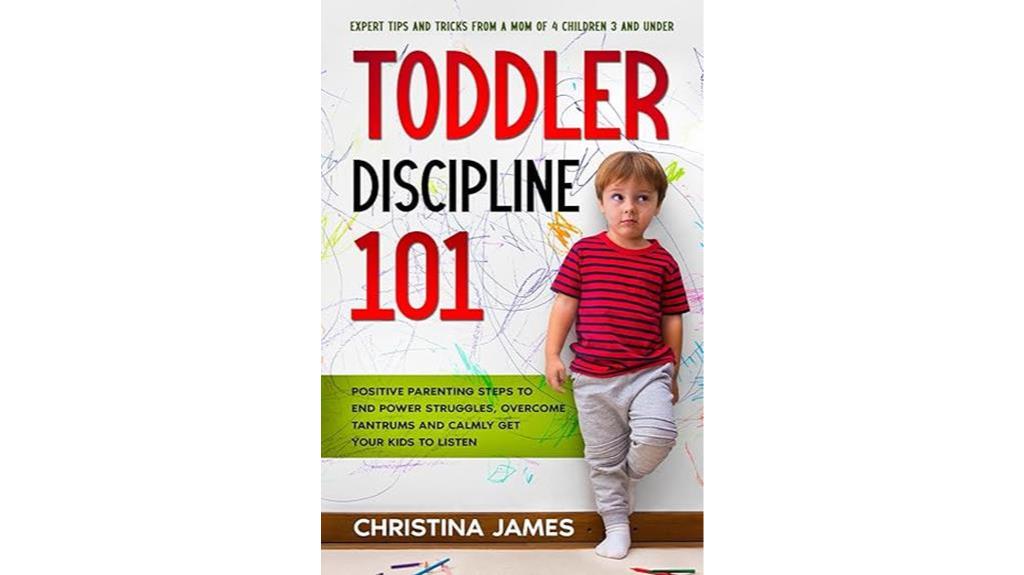
Managing the challenges of toddlerhood with positive discipline techniques is made easier with 'Parenting Books for Discipline', particularly for parents seeking effective strategies to handle power struggles and tantrums.
'Toddler Discipline 101' is a highly praised book known for its humor, informative content, and practicality. It offers valuable insights into understanding toddlers' behavior and provides coping strategies for parents dealing with power struggles and tantrums. The emphasis on gentle parenting and positive reinforcement resonates with readers, making it a helpful resource for overwhelmed parents.
Author Christina shares personal experiences and struggles as a mom, highlighting the importance of self-care, effective communication, and developing good habits for children. Practical strategies for managing toddler meltdowns, encouraging positive behavior, and fostering meaningful interactions are included, along with interactive tools to assist in developing positive habits in toddlers.
Best For: Parents seeking practical and compassionate guidance in handling toddler power struggles and tantrums.
Pros:
- Humorous and informative content that resonates with overwhelmed parents.
- Practical strategies and interactive tools to manage toddler behaviors effectively.
- Emphasis on positive parenting and self-care for a healthier parent-child relationship.
Cons:
- May not provide quick-fix solutions for all challenging toddler behaviors.
- Some parents may find the gentle parenting approach challenging to implement consistently.
- Requires dedication and patience to see long-term positive results in behavior management.
Gentle Discipline: Using Emotional Connection–Not Punishment–to Raise Confident, Capable Kids
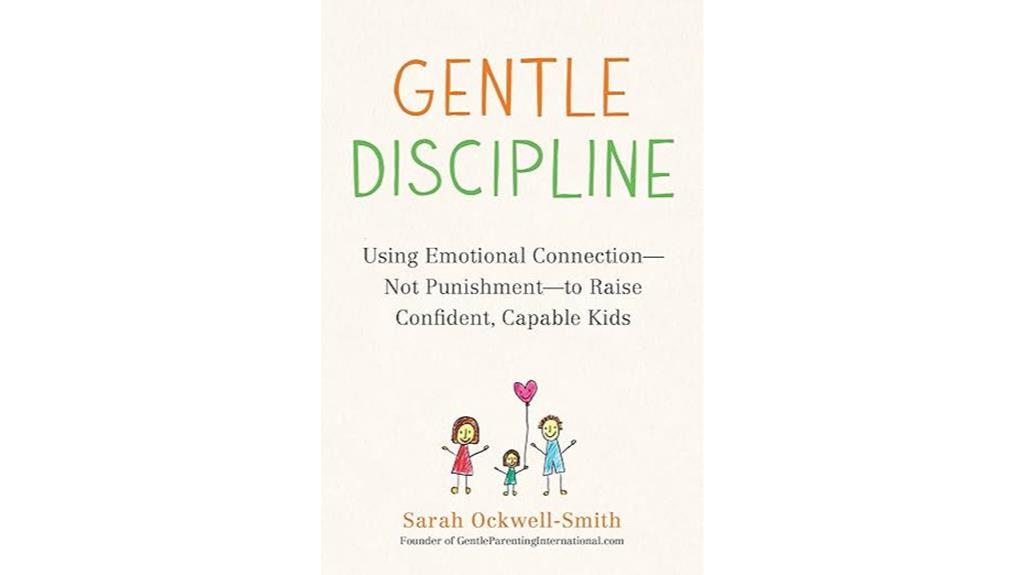
Best for parents seeking to foster emotional connection and raise confident, capable kids, the book 'Gentle Discipline' offers insightful techniques and practical strategies. This book has made a significant impact on many parents, with testimonials praising its ability to initiate positive behavior changes in children. By emphasizing emotional connection over punishment, 'Gentle Discipline' advocates for a gentler approach to parenting that focuses on understanding children's perspectives and needs.
Practical techniques provided in the book have been credited with immediate benefits, such as reduced power struggles and improved communication between parents and children. With endorsements from experts in child development, 'Gentle Discipline' stands out as a valuable resource for parents looking to cultivate a nurturing and respectful relationship with their kids.
Best For: Parents looking to foster emotional connection and raise confident, capable kids through gentle discipline techniques.
Pros:
- Encourages positive behavior changes in children.
- Emphasizes emotional connection over punishment.
- Provides practical strategies for reducing power struggles and improving communication.
Cons:
- May require a shift in parenting mindset for those used to traditional discipline methods.
- Some techniques may take time to implement effectively.
- Not all parents may resonate with the gentle discipline approach.
The Book You Wish Your Parents Had Read

For those seeking a compassionate and reflective approach to parenting, 'The Book You Wish Your Parents Had Read' by Philippa Perry offers valuable insights and practical tools for nurturing healthy relationships with their children. Perry's book explores emotional aspects of parenting, encouraging introspection about one's upbringing and providing concrete strategies for fostering communication and empathy within the family unit.
By challenging conventional parenting norms, the book advocates for a more compassionate and intentional approach to raising children, making it a valuable resource for parents at any stage. Readers have praised the book for its ability to help them understand their parenting styles better, improve connections with their children, and navigate the complexities of family dynamics.
Overall, 'The Book You Wish Your Parents Had Read' is recommended for its practical wisdom and impact on fostering emotionally healthy relationships with children.
Best For: Parents looking to deepen emotional connections with their children and improve their parenting approach.
Pros:
- Offers valuable insights on emotional aspects of parenting.
- Encourages reflection on upbringing and relationships with children.
- Provides practical tools for fostering communication and empathy within the family dynamic.
Cons:
- Some readers may find the content a mix of factual information and subjective viewpoints.
- Simplistic concepts may not cater to all parenting styles.
- Language diversity in availability may lead to varied recommendations and feedback from readers.
No-Drama Discipline: The Whole-Brain Way to Calm the Chaos and Nurture Your Child's Developing Mind

The book 'No-Drama Discipline' offers a practical and insightful approach to nurturing a child's developing mind through effective discipline strategies. This book comes highly recommended for parents and caregivers seeking to transform their disciplinary methods.
By emphasizing the importance of understanding a child's developing brain, 'No-Drama Discipline' equips readers with valuable insights into effectively managing children's behavior. Readers have reported transformative experiences, with the book challenging existing mindsets and providing a fresh perspective on discipline.
It serves as a valuable resource for honing parenting skills and has garnered praise for its practical strategies. Personal stories highlight the positive impact of this book, credited with reducing parental drama and guiding children effectively.
With a global impact, 'No-Drama Discipline' has resonated with readers worldwide, regardless of their backgrounds, offering practical tips on discipline and child development.
Best For: Parents and caregivers seeking practical and insightful discipline strategies to nurture their child's developing mind.
Pros:
- Offers practical tools to transform disciplinary methods.
- Emphasizes understanding a child's developing brain for effective behavior management.
- Recommended for honing parenting skills and reducing parental drama.
Cons:
- May require consistent implementation for noticeable results.
- Some readers may find the concepts challenging to apply initially.
- Not a quick-fix solution for discipline issues.
Parenting: 14 Gospel Principles That Can Radically Change Your Family
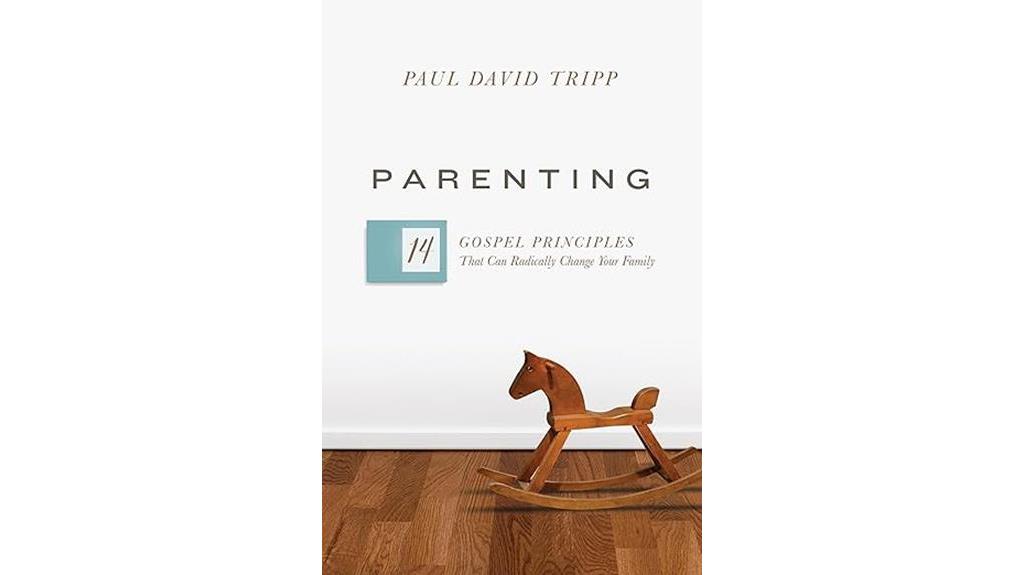
'Parenting: 14 Gospel Principles That Can Radically Change Your Family' offers insightful guidance for parents seeking to incorporate Gospel principles into their parenting approach. The book has garnered positive reviews for its wisdom and encouragement, emphasizing the significance of living out Gospel values in parenting.
It explores key concepts such as parental priorities, the necessity of God's grace, and the roles of worship, humor, and wisdom in parenting. While some readers find the book repetitive and the organization confusing, others appreciate its impact on changing their perspective on parenting.
However, critiques mention a lack of clarity in the relationship between big-picture principles and the Gospel. Despite this, the book is described as impactful, thought-provoking, and helpful for parents looking to raise Godly children.
Some readers suggest reading it in a group setting for better discussion and understanding.
Best For: Parents seeking to integrate Gospel principles into their parenting approach.
Pros:
- Offers insightful guidance on incorporating Gospel values into parenting.
- Emphasizes the importance of parental priorities and God's grace in raising children.
- Encourages the roles of worship, humor, and wisdom in the parenting journey.
Cons:
- Some readers find the book repetitive and confusing in organization.
- Lack of clarity in the relationship between big-picture principles and the Gospel.
- Critiques mention feeling overwhelmed by minor principles and tips within chapters.
Positive Discipline: Classic Guide for Children's Self-Discipline
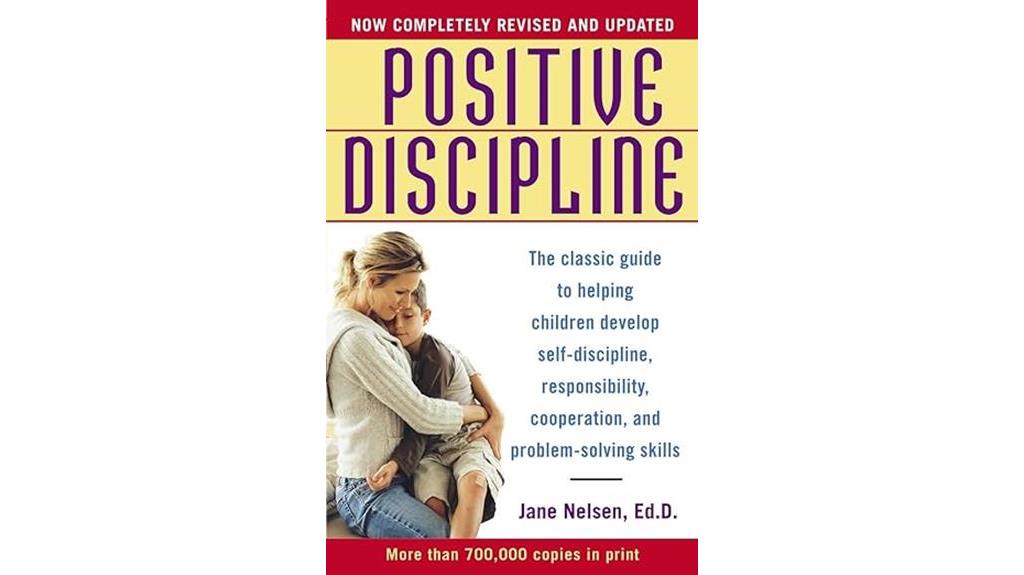
Optimizing children's self-discipline through effective parenting techniques, the book 'Positive Discipline: The Classic Guide to Helping Children Develop Self-Discipline, Responsibility, Cooperation, and Problem-Solving Skills' stands out as a valuable resource for those seeking positive and empowering approaches to discipline.
This latest edition showcases the evolution of author Jane's insights, emphasizing solutions-based parenting over punitive measures. Reader reviews highlight practical applications in personal and professional settings, noting the positive impact on interactions with children and behavior management. By understanding and addressing children's emotional needs, the book encourages cooperation and empowerment.
Readers have experienced transformations in their parenting styles, leading to improved communication, conflict resolution, and the cultivation of positive relationships with their children. Recommendations emphasize the positive influence of implementing the book's principles on family dynamics and overall well-being.
Best For: Parents and caregivers looking for a positive and effective approach to discipline that promotes children's self-discipline and overall well-being.
Pros:
- Offers practical solutions-based parenting techniques.
- Emphasizes understanding and addressing children's emotional needs.
- Encourages cooperation and empowerment in children.
Cons:
- May require a shift in parenting mindset and practices.
- Implementation of techniques may take time and consistency.
- Some individuals may prefer more traditional disciplinary methods.
How to Talk So Kids Will Listen & Listen So Kids Will Talk

Ideal for parents seeking practical techniques for improving communication with their children, 'How to Talk So Kids Will Listen & Listen So Kids Will Talk' presents valuable strategies and insights. This book offers a range of effective communication methods that can be easily implemented in everyday interactions with children.
It focuses on fostering a deeper connection through active listening and empathetic responses. Readers have found the advice in this book to be practical and applicable to various parenting challenges. By emphasizing the importance of reflective parenting and providing specific phrases for different situations, 'How to Talk So Kids Will Listen & Listen So Kids Will Talk' equips parents with the tools they need to enhance their communication skills with their children.
It's highly recommended for parents looking to create a more harmonious and understanding relationship with their kids.
Best For: Parents and caregivers seeking practical and effective strategies to improve communication with their children.
Pros:
- Provides valuable and manageable techniques for handling parenting challenges.
- Encourages reflective parenting and offers specific phrases for real-life situations.
- Offers fresh perspectives and practical exercises that are insightful and helpful for improving parenting styles.
Cons:
- Some readers feel the book has become longer and more intimidating over time.
- Suggestions for a newer, shortened edition without unnecessary filler content have been made.
- Despite minor criticisms, it is still considered a good read with valuable tips and tricks.
The Discipline Book: Better-Behaved Child From Birth to Age Ten

For those seeking practical guidance on fostering positive parent-child relationships and implementing gentle discipline methods, 'The Discipline Book: Better-Behaved Child From Birth to Age Ten' is a valuable resource. This book has garnered positive reviews for its sound advice in raising well-behaved children, making it a recommended read for new parents.
One of its key strengths lies in focusing on self-discipline for parents, which sets the foundation for a positive and cooperative parent-child dynamic. By emphasizing listening and collaboration with children, the book advocates for gentle and loving discipline techniques. Personal testimonials highlight how the book has positively impacted parenting styles, leading to improved behavior in children.
It's suggested to combine this book with others by the same author team to gain a holistic approach to parenting. The book also addresses misconceptions about solely disciplining children, emphasizing the importance of self-discipline and a shift towards positive parenting practices.
Best For: Parents seeking practical guidance on fostering positive parent-child relationships and implementing gentle discipline methods.
Pros:
- Offers sound advice for raising well-behaved children.
- Emphasizes self-discipline for parents to establish a positive parent-child dynamic.
- Advocates for gentle and loving discipline methods.
Cons:
- May require a significant shift in parenting approach for some individuals.
- Not suitable for those looking for quick-fix or punitive discipline techniques.
- Some readers may find the emphasis on self-discipline challenging to implement.
Positive Discipline Parenting Tools
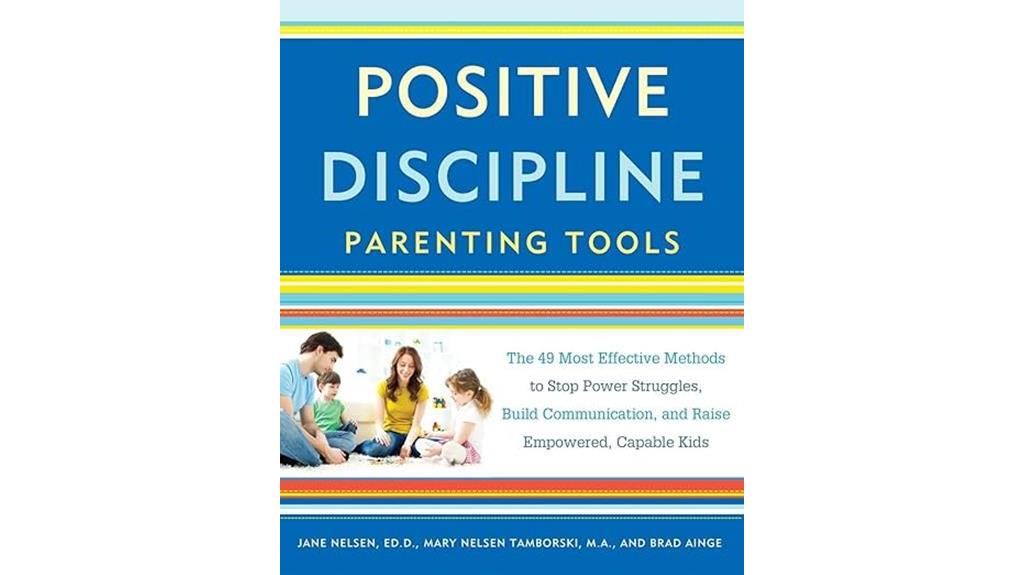
These Positive Discipline Parenting Tools are recommended for parents seeking practical and effective strategies to improve their relationships with their children and foster a positive discipline mindset.
The book contains 49 tools for positive parenting, each explained in a chapter. Divided into sections by Jane Nelsen, her daughter Mary, and son Brad, it offers insights and reflections on motivations and reactions.
Emphasizing 'connecting before correcting,' it encourages implementing skills gradually and provides everyday life examples for better understanding. Readers appreciate the book's useful communication tools, short, easy-to-read chapters, and success stories from Positive Discipline Trainers.
With a focus on a positive discipline mindset, the tools aim to support the bond between parent and child, offering a kind but firm approach for effective parenting.
Best For: Parents looking for practical and effective tools to improve their relationships with their children and implement a positive discipline mindset.
Pros:
- Provides 49 effective tools for positive parenting
- Encourages gradual implementation of skills
- Offers insights and reflections on motivations and reactions
Cons:
- May require time and effort to fully incorporate the tools into parenting practices
- Some readers may prefer more detailed explanations for certain tools
- Not all strategies may work for every family dynamic
Positive Discipline for Kids: Essential Guide for Managing Children's Behavior & Effective Communication
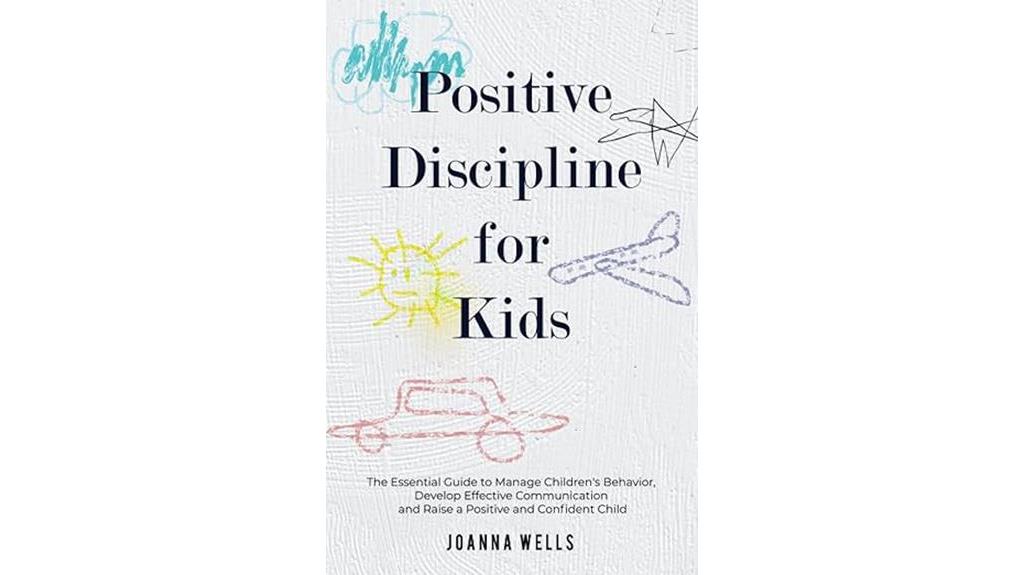
When seeking effective strategies for managing children's behavior and enhancing communication skills, Joanna Wells' Positive Discipline for Kids is an invaluable resource for parents. This detailed guide explores understanding child behavior, promoting effective communication, and fostering a positive and confident environment for children to thrive.
The book places a strong emphasis on the psychological health of parents, highlighting the significance of being emotionally balanced to model positive behavior. By advocating for a positive discipline approach, it encourages parents to guide behavior rather than categorize children as good or bad.
Practical Discipline for Kids offers clear guidance on respectful parenting styles, emphasizing the importance of separating the child from their actions and steering away from punishment-reward systems. Readers have found this book insightful and informative, recommending it for all parents looking to enhance their parenting skills and strengthen parent-child relationships.
Best For: Parents seeking practical guidance on positive discipline and effective communication with their children.
Pros:
- Offers valuable insights on understanding child behavior and fostering a positive environment.
- Provides clear guidance on respectful parenting styles and effective discipline strategies.
- Emphasizes the importance of parental psychological health and modeling positive behavior.
Cons:
- May require consistent effort and practice to implement the recommended strategies.
- Some parents may find it challenging to separate behavior from the child in disciplinary situations.
- The approach advocated may not resonate with all parenting styles or preferences.
Positive Parenting for Toddlers: Effective Discipline Strategies (All Things Parenting)
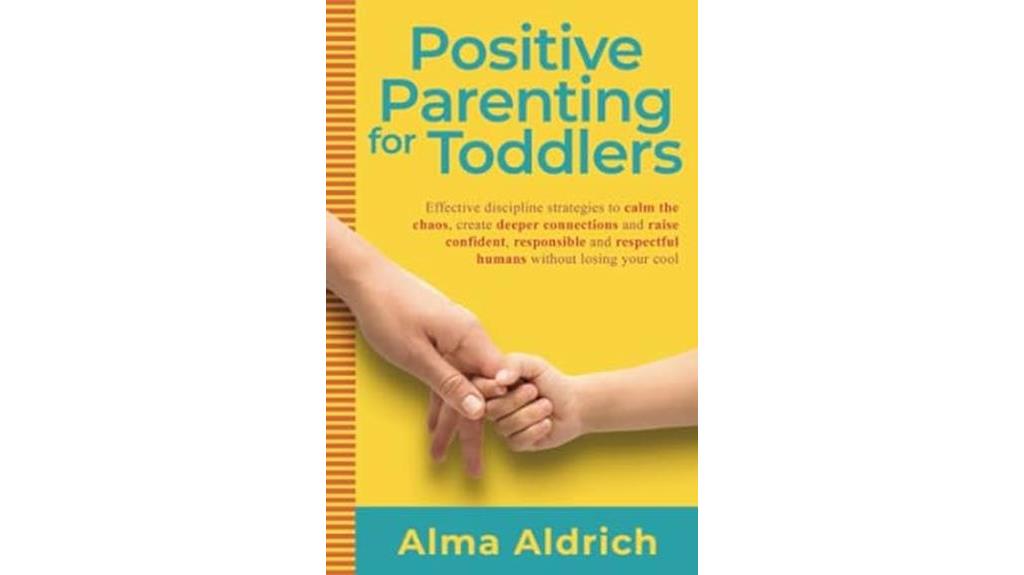
The book 'Positive Parenting for Toddlers: Effective Discipline Strategies' offers essential guidance to parents managing the challenging toddler years. It explores traditional parenting models such as authoritarian, permissive, neglectful, and authoritative, providing practical methods to nurture confident, responsible, and resilient individuals.
Emphasizing understanding toddler behavior and staying calm, the book guides parents in fostering respect, responsibility, and connection with their little ones. By focusing on addressing misbehavior and patience-testing situations, it equips parents with valuable tools to navigate the tumultuous toddler phase.
Readers recommend this book as a short, practical read that's indispensable for all toddler parents, praised for shedding light on different parenting styles. With author Alma Aldrich's personal insights and expertise, this book serves as a solid template for parents seeking harmony in their parenting journey.
Best For: Parents seeking practical guidance and effective strategies to navigate the challenges of the toddler years with confidence and patience.
Pros:
- Offers practical methods based on traditional parenting models.
- Emphasizes understanding toddler behavior and maintaining calm.
- Provides valuable tools for fostering respect, responsibility, and connection with toddlers.
Cons:
- May not cater to parents looking for quick-fix solutions.
- Some readers may find the book's approach too idealistic for real-life parenting scenarios.
- Requires consistent effort and practice to implement the strategies effectively.
Factors to Consider When Choosing Parenting Books for Discipline

When selecting parenting books for discipline, it's vital to take into account key factors like:
- The book's relevance to your parenting style.
- The practical application tips provided.
- The potential impact on the parent-child relationship.
Ensuring alignment with your discipline philosophy is also essential for effective implementation of the strategies outlined in the book. By evaluating these factors, parents can choose a book that resonates with their approach to discipline and enhances their parenting journey.
Key Considerations in Selection
Considering the parenting approach that aligns with our values and beliefs is essential when selecting parenting books for discipline. It's vital to resonate with the discipline style advocated in the book, whether it's positive discipline, gentle parenting, or a more authoritarian approach.
Checking the author's credentials, experience, and expertise in child development can help gauge the book's credibility. Evaluating the practicality and applicability of the discipline techniques offered is also important to make sure they suit our family dynamics.
Seeking reviews and recommendations from trusted sources or other parents can provide insights into the book's effectiveness. Looking for books that offer practical tips and strategies aligned with our parenting style and values can make the discipline methods more applicable.
Additionally, considering the book's focus on positive discipline techniques over punitive methods and its relevance to specific age groups or behavioral challenges our child faces can further guide our selection process.
Relevance to Parenting Style
When selecting parenting books for discipline, it's vital to align the strategies and methods with our existing parenting style and beliefs. Considering how the book resonates with our approach to disciplining children is imperative. It's beneficial to choose a book that complements our parenting philosophy and values.
Practicality is key, so ensuring that the methods and techniques suggested in the book are feasible for our family dynamics is significant. Look for a book that provides a balanced perspective on discipline and matches our preferred parenting style, whether it be Authoritarian, Permissive, or Authoritative, for effective discipline.
Practicality is essential, so seek books that offer actionable methods and strategies in line with our parenting approach. Additionally, the selected book should address our specific concerns or challenges related to discipline while aligning with our parenting style.
Practical Application Tips
To make an informed choice when selecting parenting books for discipline, we should carefully evaluate the practicality of the discipline methods presented in the book for our family's unique dynamics. It's important to look for books that offer step-by-step guides or actionable strategies that can be easily implemented in our daily routines.
Real-life examples and scenarios provided in the book can also be beneficial in understanding how to apply the discipline techniques effectively. Additionally, considering if the book addresses different age groups or specific challenges we're facing in disciplining our child can help tailor the strategies to our specific needs.
Emphasizing consistency, positive reinforcement, and long-term behavioral changes over quick fixes is essential. Therefore, choosing a book that focuses on practical strategies which align with our parenting style and values is key.
Impact on Parent-Child Relationship
Parenting books for discipline have the potential to greatly impact the parent-child relationship by offering effective communication strategies. These books provide valuable insights into understanding children's behavior, promoting empathy, and nurturing trust between parents and children.
By implementing the discipline techniques recommended in these books, parents can cultivate a more harmonious and respectful relationship with their child. Positive discipline methods emphasized in these resources encourage mutual respect, collaboration, and emotional connection within the parent-child dynamic.
Following the guidance from parenting books can't only enhance the bond between parents and children but also help in effectively managing behavior issues. By utilizing positive parenting techniques, parents can strengthen their relationship with their children by fostering trust and understanding.
Implementing effective discipline strategies can foster open communication, mutual respect, improved cooperation, and collaboration within the parent-child relationship, ultimately contributing to a supportive and loving environment that benefits the well-being of both parents and children.
Alignment With Discipline Philosophy
Considering our own discipline philosophy and values is vital when selecting parenting books for guidance on discipline techniques and strategies. It's important to look for books that align with our parenting style and beliefs about discipline. Making sure that the book's approach to discipline matches our views on child development is essential.
We should seek practical advice that we can easily implement in our daily parenting routine. Evaluating whether the book addresses specific discipline challenges we're facing with our child is crucial for finding relevant solutions. By choosing a parenting book that resonates with our discipline philosophy and values, we can ensure it complements our approach to parenting.
Look for practical strategies and techniques that fit our parenting style and beliefs. Evaluate if the book provides insights and guidance on fostering positive behavior and communication, in line with our disciplinary goals. Assess if the book emphasizes understanding child development and behavior to support effective discipline practices tailored to our child's age and stage.
Authoritative Content Evaluation
When selecting parenting books for discipline, it's important to carefully evaluate the credibility and expertise of the author in child development and psychology. Look for evidence-based content supported by research and studies. Consider the author's expertise, qualifications, and background in child psychology or education. Check for endorsements or recommendations from professionals in the field.
Make sure the book provides practical strategies and tools that can be implemented effectively. It's essential to choose books that align with your parenting style and values. Seek out publications that offer evidence-based strategies and techniques backed by research in child development and parenting.
Assess the book's approach to discipline, whether it emphasizes positive reinforcement, communication skills, setting boundaries, or understanding child behavior. Evaluate the readability and practicality of the content, ensuring it offers clear, actionable advice that's easy to implement in daily parenting situations.
Additionally, check for reviews and recommendations from parenting experts, therapists, or other parents to gauge the book's effectiveness and impact on real-life parenting challenges.
Integration With Family Dynamics
How can the discipline methods outlined in parenting books be effectively integrated into the unique dynamics of our family unit?
When selecting a parenting book for discipline, it's important to take into account how well the techniques align with our family values and beliefs.
Evaluating if the discipline methods can seamlessly fit into our daily routines is vital for practical implementation.
Look for strategies that can be adapted to suit the distinct dynamics present within our family structure.
It's beneficial to choose a book that offers flexibility in its approach to discipline, accommodating the various parenting styles within our household.
Additionally, make sure that the parenting book provides guidance on handling diverse situations that may arise within our family, addressing specific challenges or dynamics that we might encounter.
Assess if the book offers insights on adapting discipline strategies to cater to the individual needs and personalities of our children, emphasizing the importance of building positive relationships and communication within our family unit.
Frequently Asked Questions
Will These Parenting Books Work for Children With Special Needs?
For children with special needs, it's vital to assess if the parenting books recommended are suitable for their unique circumstances. Factors such as the strategies and techniques offered, the flexibility of the approach, and the ability to adapt to individual needs should be carefully evaluated.
In some cases, specialized resources tailored to children with special needs may be more beneficial. It's important to prioritize the well-being and development of these children when selecting parenting guides.
Are There Specific Techniques for Different Age Groups?
Different age groups require tailored discipline techniques. Younger children may benefit from simple rules and consistent consequences, while teenagers may respond better to logical reasoning and discussions about consequences.
Understanding developmental stages can guide parents in choosing appropriate strategies. It's like customizing a recipe for each dish; one size doesn't guarantee all.
Adapting discipline to suit different age groups promotes effectiveness and fosters a positive parent-child relationship.
How Can I Incorporate These Strategies Into My Busy Schedule?
Incorporating discipline techniques into our busy schedules requires planning and consistency. We can create a daily routine that includes short, regular intervals for discipline strategies.
Utilize tools like timers or calendar reminders to stay on track. Also, involve the whole family by assigning tasks and responsibilities, making discipline a team effort.
Prioritize self-care to manage stress and maintain a positive mindset when implementing these strategies.
Do These Books Address Handling Sibling Rivalry and Conflicts?
Yes, these books provide practical advice on managing sibling rivalry and conflicts. They explore techniques for fostering positive relationships among siblings, such as teaching conflict resolution skills and promoting empathy.
Imagine a toolbox filled with strategies to navigate through disagreements and promote harmony at home. By implementing the suggestions from these books, parents can equip themselves with effective tools to address and reduce sibling conflicts, fostering a more peaceful household.
Are There Tips for Single Parents or Blended Families?
In single-parent or blended families, it's crucial to find strategies that work for your unique situation. Look for books that offer advice tailored to the dynamics of single parenting or blended families.
Tips on communication, setting boundaries, and fostering positive relationships can be particularly beneficial. Seek guidance on managing different parenting styles, handling co-parenting challenges, and supporting children through changes.
Finding resources that resonate with your family structure can make a significant difference in your parenting journey.
Conclusion
To sum up, selecting the right parenting book for discipline is crucial for effective and positive parenting. By taking into account factors such as the author's expertise, parenting philosophy, and practical strategies, parents can discover valuable resources to navigate the challenges of raising children.
So, why not invest in a book that can offer guidance and support in fostering a healthy and harmonious relationship with your child?
Vetted
15 Best Baby Emotions Books to Help Your Little One Understand Feelings
Peek into the world of emotions with the top 15 baby books that promise to unravel your little one's feelings in a delightful way!

Picking **books on baby emotions** helps little ones grasp feelings. Look for titles like **’Baby Faces’** and **’The Feelings Book’** which dive right into emotions. **’Babys Feelings’** and **’Making Faces’** help kids get a handle on feelings early. Try **interactive books** like **’Baby Einstein – My First Feelings Mirror Book’** which has touchy-feely parts. For positive thoughts, check out **’I Am: Positive Affirmations for Kids.’** Remember to consider how suitable the book is for your kid’s age and its engagement level. Each book carries unique benefits, gently building emotional understanding.
Key Takeaways
- Look for books with interactive features like flaps, mirrors, and touch-and-feel elements.
- Choose books that cover a wide emotional range from happiness to sadness.
- Opt for age-appropriate content that resonates with your child's developmental stage.
- Prioritize engaging visuals with colorful illustrations and diverse characters.
- Consider books with positive affirmations and strategies for emotional regulation.
Babys Feelings – A First Book of Emotions – Educational

For parents seeking an engaging and educational tool to help their young children understand and express emotions, Babys Feelings – A First Book of Emotions is the perfect choice. This board book, featuring a soft padded cover, captures the attention of children aged 1 to 5 years old with its sweet photos of real babies displaying various emotions.
The book's durability and engaging content have garnered positive feedback from parents and caregivers, who appreciate its ability to help children communicate and comprehend feelings like happy, angry, sad, and surprised.
Through interactive learning, children are encouraged to mimic the facial expressions depicted, fostering emotional awareness and expression. With 24 pages and dimensions of 7 inches x 7 inches, this book isn't only educational but also a valuable tool for children's emotional development.
Best For: Parents looking for an interactive and durable educational tool to help their young children understand and express basic emotions effectively.
Pros:
- Diverse range of emotions depicted by real babies.
- Engaging content that encourages children to mimic facial expressions.
- Helps children communicate and comprehend feelings like happy, angry, sad, and surprised.
Cons:
- Limited to basic emotions, may not cover more complex feelings.
- Targeted age group may not engage older children.
- Some children may not find the book visually appealing.
Making Faces: A First Book of Emotions (Baby Loves Books)
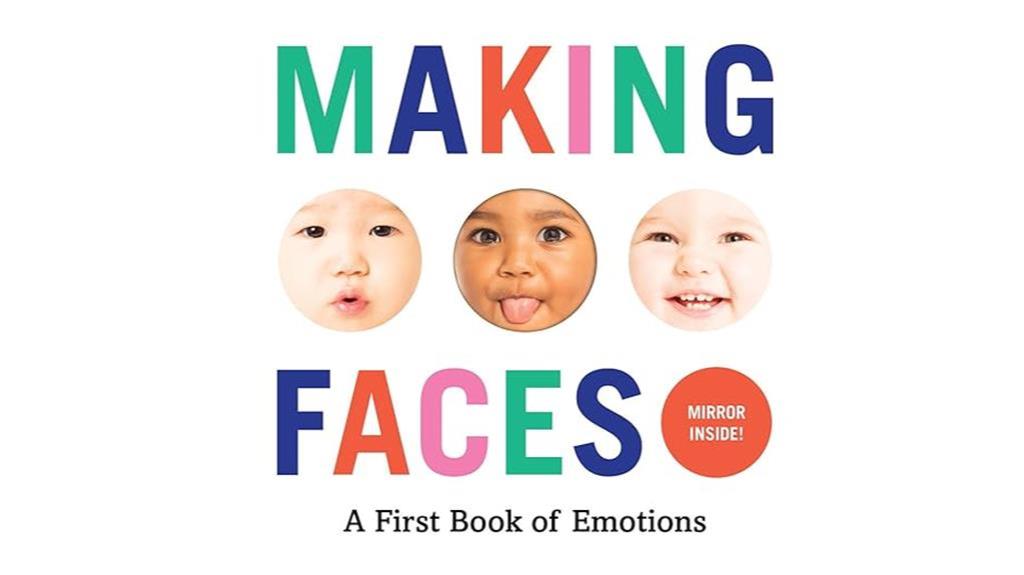
Interested in a book that uses real baby faces to teach emotions interactively? 'Making Faces: A First Book of Emotions (Baby Loves Books)' is a highly recommended choice for engaging your little one in learning about feelings.
This interactive photographic board book introduces essential expressions like happy, sad, angry, surprised, and silly through real baby faces instead of cartoons. It encourages children to mimic and identify these emotions, fostering important developmental skills.
The mirror feature included in the book allows children to see their own facial expressions and encourages them to mimic different emotions, making the learning experience more immersive and enjoyable.
With positive reviews praising its educational value and interactive nature, this book is a valuable tool for helping children understand and express their feelings effectively.
Best For: Parents looking for an interactive and educational book to teach children about emotions through real baby faces.
Pros:
- Encourages children to mimic and identify essential expressions
- Includes a mirror feature for children to see and mimic their own facial expressions
- Highly recommended for children with special needs or autism
Cons:
- Limited language options available for multilingual households
- May not appeal to children who prefer cartoon illustrations
- Mirror feature could potentially break if mishandled
Baby Faces
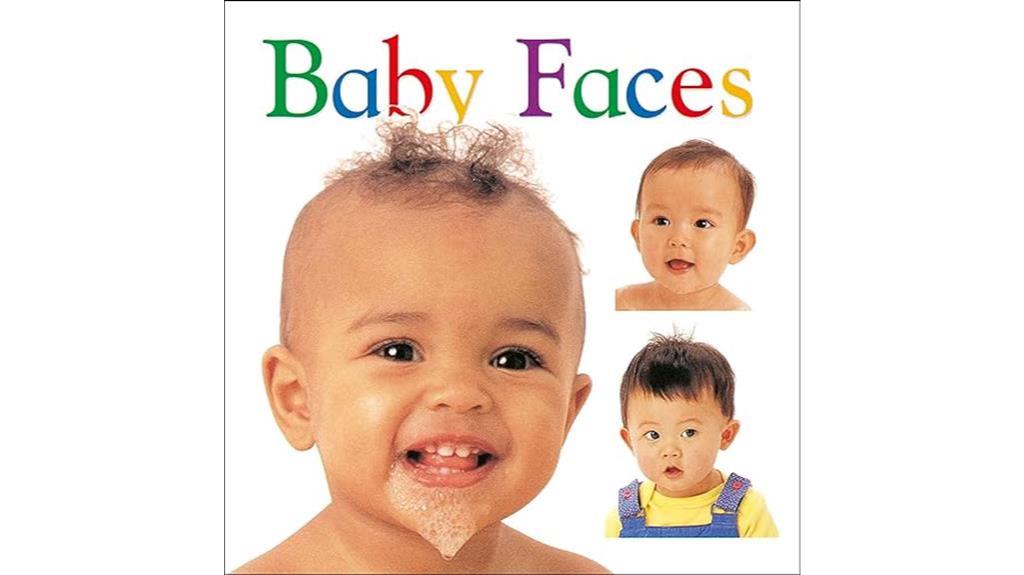
The enchanting photos of baby faces displaying various emotions in the book 'Baby Faces' are ideal for introducing young children to recognizing and understanding different feelings.
This sturdy board book features bright and colorful images of babies showing emotions like happiness, sadness, sleepiness, and more. The simple word labels accompanying each photo help babies and toddlers associate the expressions with the corresponding feelings.
The durable pages make it a long-lasting addition to a child's library, perfect for repeated readings and exploration. 'Baby Faces' is designed to engage young minds in early childhood development by familiarizing them with common facial expressions and aiding in their emotional understanding.
This book offers a valuable tool for parents and caregivers to support children in learning about and expressing their emotions effectively.
Best For: Parents looking to introduce their babies and toddlers to recognizing and understanding different emotions through engaging and colorful visuals.
Pros:
- Engaging photos of baby faces displaying various emotions.
- Simple word labels accompanying each photo for easy association.
- Sturdy board book with durable pages, making it long-lasting for young children.
Cons:
- Limited focus on a range of complex emotions.
- May not have extensive interactive features for further engagement.
- Some parents may prefer a more interactive learning approach.
Baby Einstein – My First Feelings Mirror Book – PI Kids
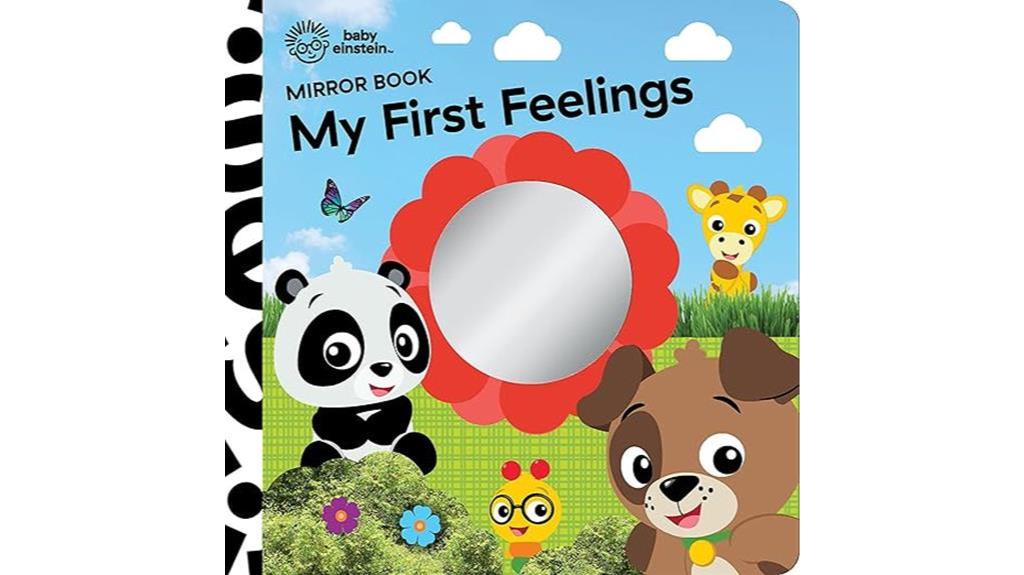
With its engaging mirrors and interactive prompts, the Baby Einstein – My First Feelings Mirror Book – PI Kids is a perfect choice for babies who enjoy exploring their own expressions and emotions. This book features five shaped mirrors that allow curious eyes to discover faces and emotions, creating an interactive and fun learning experience.
As caregivers read the book, little ones are prompted to make faces into the mirrors, encouraging a playful interaction that helps children understand feelings in an engaging way. Customer reviews highlight the enjoyment babies experience while looking at themselves in the mirrors, with comments emphasizing how the book grows with the child.
The colorful illustrations and adorable Baby Einstein animals further enhance the overall appeal of this mirror book, making it a valuable addition to a baby's library.
Best For: Parents looking for a interactive book that helps babies explore their own expressions and emotions through mirrors.
Pros:
- Interactive mirrors engage babies in discovering faces and emotions.
- Encourages playful interaction between child and caregiver.
- Helps children understand feelings in an engaging way.
Cons:
- May require supervision to ensure safe use of mirrors.
- Limited content beyond the interactive mirror feature.
- Some babies may lose interest if not attracted to their own reflection.
The Feelings Book
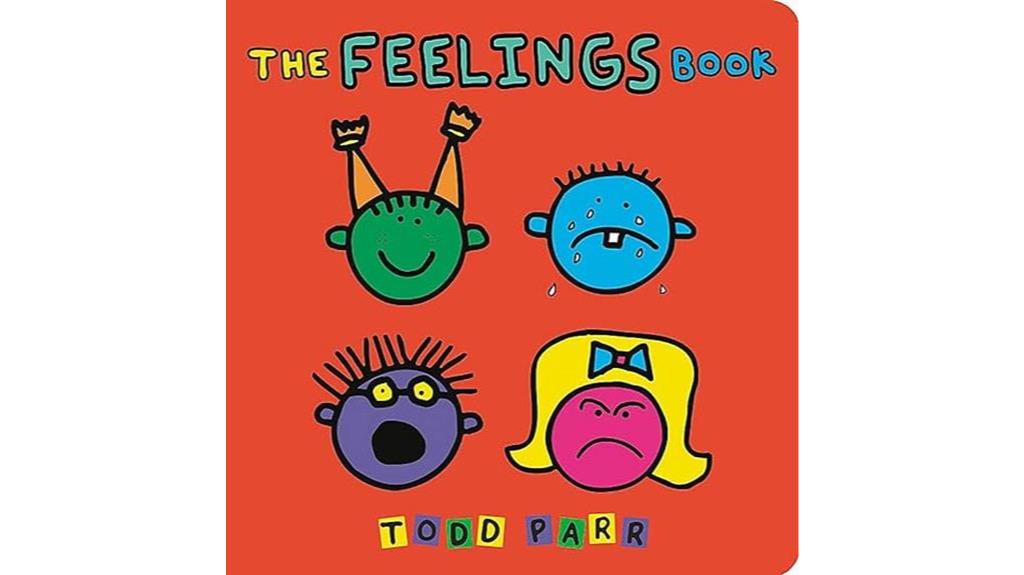
For parents seeking a vibrant and engaging book to help their young children understand and accept a wide range of emotions, 'The Feelings Book' by Todd Parr is an excellent choice. This colorful and fun book is designed to assist kids in comprehending and embracing their feelings through bold, simple, and silly illustrations that resonate with young readers.
Todd Parr's ability to convey subtle yet effective messages about emotions has garnered praise for 'The Feelings Book'. Known for its vibrant childlike illustrations, this book discusses various emotions in a concrete and relatable manner, making it a valuable tool for initiating conversations about feelings with children.
Readers appreciate the pedagogical value of Todd Parr's work, finding his books, including 'The Feelings Book', instrumental in helping children navigate and understand their emotions in a positive and engaging way.
Best For: Parents looking for a colorful and engaging tool to help young children understand and accept their emotions effectively.
Pros:
- Vibrant and engaging illustrations that appeal to young readers.
- Subtle yet impactful messages about emotions.
- Effective in initiating conversations about feelings with children.
Cons:
- May be too simplistic for older children or advanced readers.
- Limited depth in emotional exploration compared to more in-depth resources.
- Some parents may prefer a more comprehensive guide to emotions for children.
My First Book of Emotions for Toddlers
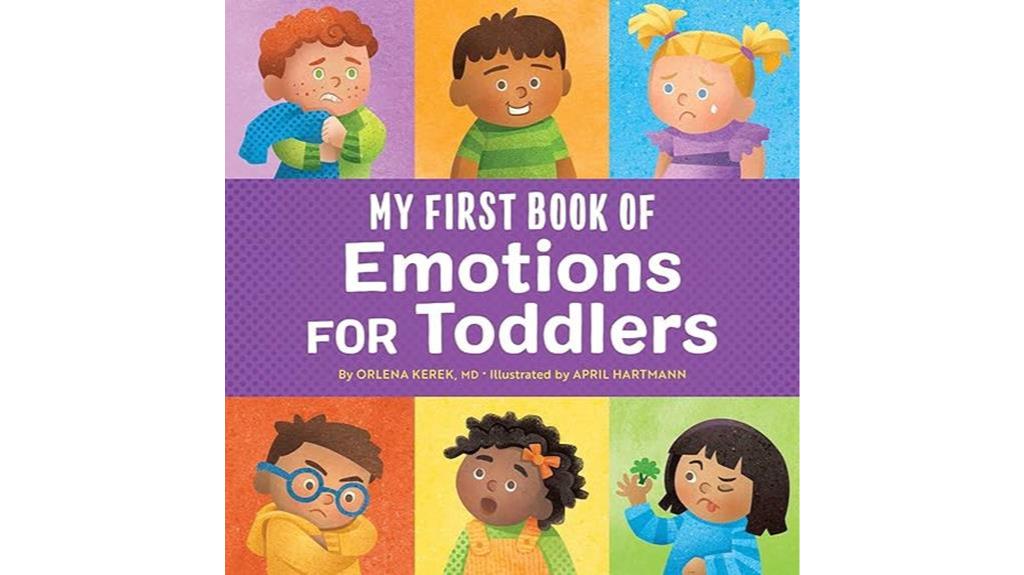
Best choice for toddlers exploring emotions: 'My First Book of Emotions.' This engaging book introduces young children to a range of common feelings, aiding them in understanding and managing their emotions.
With colorful illustrations and simple language, it covers essential emotions like fear, anger, joy, sadness, disgust, and surprise.
Parents appreciate how this book helps regulate emotions and encourages discussions about feelings, fostering emotional intelligence in children aged 3 and up.
Grandparents have observed their grandchildren preferring this book over others, citing its ability to stop emotional outbursts and expand vocabulary.
The artwork is vibrant and diverse, depicting various emotions, making it an excellent tool for promoting interaction, speech development, and communication skills in toddlers.
Best For: Parents seeking a colorful and engaging tool to help toddlers understand and manage a range of emotions effectively.
Pros:
- Introduces toddlers to essential emotions in a simple and engaging manner
- Encourages emotional regulation and vocabulary expansion
- Promotes discussions about feelings and nurtures emotional intelligence from a young age
Cons:
- Might not be suitable for children under 3 years old due to complexity of emotions covered
- Some parents may prefer more text or detailed explanations in the book
- Artwork suggestions for better visibility may not align with personal preferences
I Am: Positive Affirmations for Kids
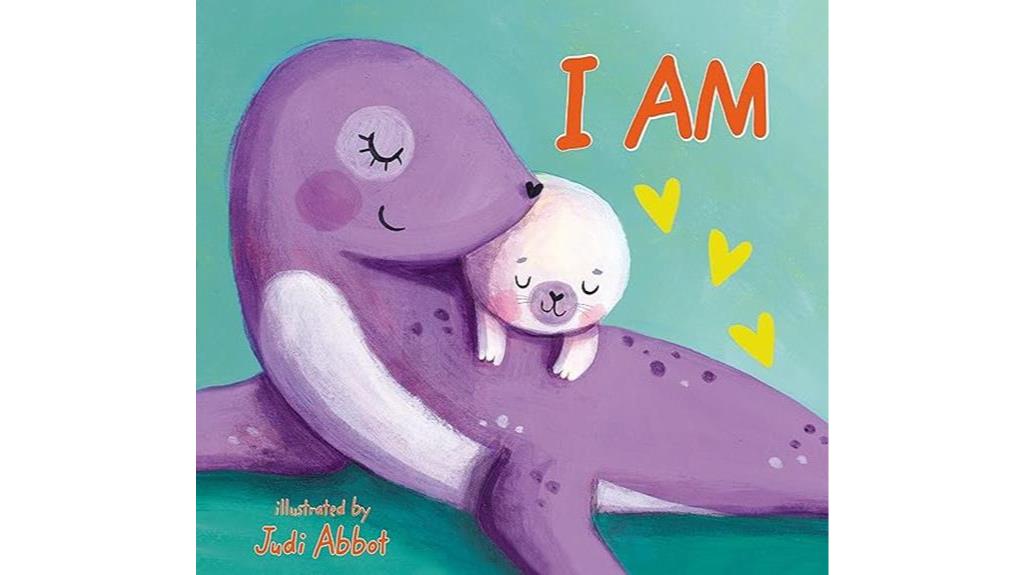
'I Am: Positive Affirmations for Kids' is a valuable resource for parents looking to instill confidence and positivity in their young children through empowering affirmations. This book has garnered positive reviews, with parents noting how their children love reciting the affirmations and how it helps in building their confidence.
The impact on children is evident, with little ones repeating affirmations and visibly perking up during tough moments. The book features simple wording, easy-to-read text, and charming illustrations that appeal to children.
By emphasizing affirmations like 'I am strong, I'm kind, and I'm smart,' 'I Am' empowers children and reinforces positive self-perception. Parents appreciate the book's ability to instill positive thoughts and self-acceptance in their young ones, making it a beloved addition to their children's book collection.
Best For: Parents looking to instill confidence and positivity in their young children through empowering affirmations.
Pros:
- Empowers children with affirmations like 'I am strong, I am kind, and I am smart'.
- Features simple wording and charming illustrations that appeal to children.
- Helps toddlers ages 0 to 4 build confidence and create a foundation of positivity and self-acceptance.
Cons:
- May be too simplistic for older children.
- Limited content for extended use over time.
- Some children may lose interest in repetitive affirmations.
Little Monkey Calms Down (Hello Genius)
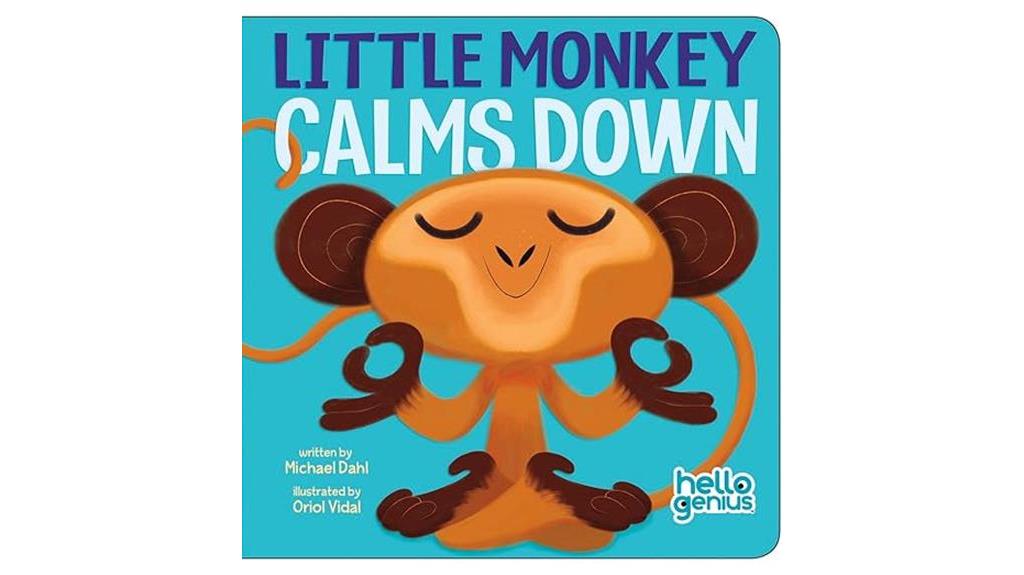
Parents and educators have noted that 'Little Monkey Calms Down' from the 'Baby Emotions Books' series is particularly beneficial for children with special needs, such as language delays or processing issues. This book's simple word structure and expressive illustrations make it easier for children with autism to relate to, aiding in emotional understanding and regulation.
While the book provides suggestions for self-calming, parents may need to customize these strategies to suit their child's specific needs. The overall message that calming down is a skill within the child's control has been well received by both parents and professionals.
'Little Monkey Calms Down' has proven effective in helping children manage and soothe negative emotions, fostering improvements in emotional intelligence and self-soothing efforts.
Best For: Children with special needs, such as language delays or processing issues, who benefit from simplified language and expressive visuals for emotional understanding.
Pros:
- Effective in helping children manage and soothe negative emotions.
- Simple word structure and colorful illustrations aid in emotional regulation.
- Parents and caregivers appreciate the book's message of self-calming and emotional control.
Cons:
- Some strategies for self-calming may require additional customization for individual children.
- Limited focus on specific special needs beyond language delays and processing issues.
- May not appeal to children who prefer more complex storylines or illustrations.
Baby Faces Peekaboo!: With Mirror, Touch-and-Feel, and Flaps
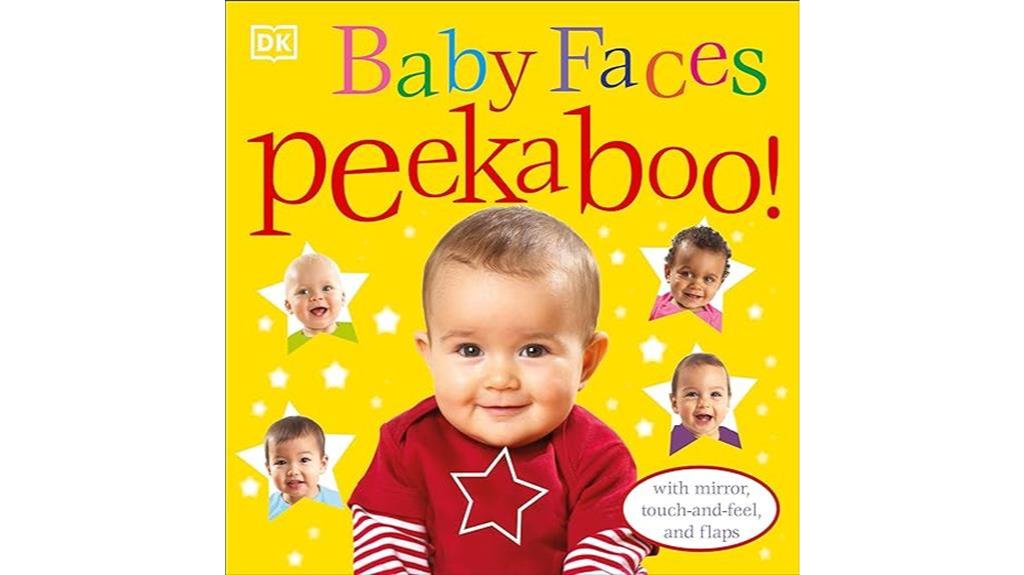
Ideal for babies who are starting to sit up independently, 'Baby Faces Peekaboo!: With Mirror, Touch-and-Feel, and Flaps' offers a stimulating and interactive introduction to emotions through its diverse features. This big and sturdy book is designed for tummy time, featuring a mirror page and showcasing babies of various races expressing different moods.
With a focus on textures, patterns, and empathy, the book engages babies through touch-and-feel elements and interactive flaps. Parents find that the large, sturdy pages make it easy for babies to explore on their own, fostering independence. Children enjoy the different baby faces and emotions depicted, particularly loving the touch-and-feel components and the mirror page.
Highly recommended for babies who can sit up, crawl, and stand, this book continues to captivate children's attention and remains a favorite over time.
Best For: Parents looking for a stimulating and interactive book to introduce emotions to babies during tummy time.
Pros:
- Engages babies through touch-and-feel elements and interactive flaps.
- Features babies of different races expressing various moods, promoting diversity and empathy.
- Large, sturdy pages make it easy for babies to explore independently, fostering motor skills and independence.
Cons:
- Some users initially found the book too big and crowded for younger babies.
- Recommended for babies who can sit up, which may limit its usability for younger infants.
- The size and number of pages in the book may surprise some users.
Babies Love Kindness Lift-a-Flap Board Book
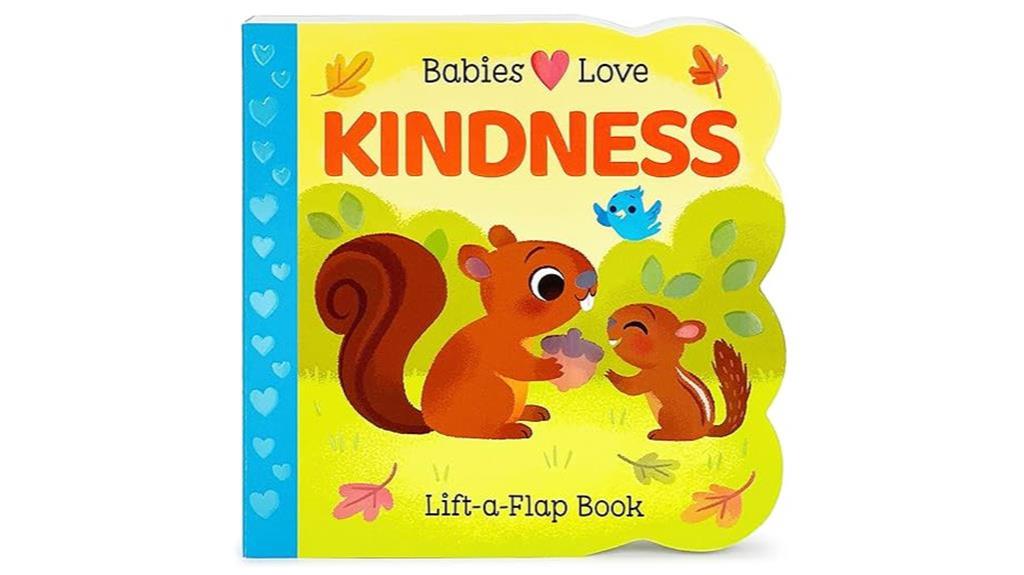
Perfect for introducing babies and toddlers to empathy and kindness, the 'Babies Love Kindness Lift-a-Flap Board Book' offers engaging illustrations and interactive elements to foster social-emotional learning. This board book, part of the Cottage Door Press collection, features colorful and appealing illustrations that attract young children's attention. With 6 sturdy flaps and 12 pages, it encourages interaction, supporting fine motor skill development in little ones.
Parents appreciate the focus on teaching kindness and empathy to children, though some have varying opinions on the phrasing used. The book's durability stands out, with sturdy flaps that can withstand active play. It introduces concepts like helping others and sharing positive words, making it an ideal choice for early learning about emotions and social values.
Designed for babies and toddlers, this book is recommended for its engaging content and durable construction.
Best For: Parents looking to introduce their babies and toddlers to concepts of empathy and kindness through interactive learning.
Pros:
- Engaging illustrations and interactive elements enhance social-emotional learning.
- Durable flaps and sturdy construction make it suitable for active play.
- Introduces important values like helping others and sharing positivity in a fun and educational manner.
Cons:
- Some parents may find the wording in the book less appealing or not as effective in conveying the intended message.
- The thickness of the board book may pose a slight challenge for very young children to handle independently.
- Limited content may not fully cover all aspects of teaching empathy and kindness, depending on individual preferences.
How Does Baby Feel?: A Karen Katz Lift-the-Flap Book
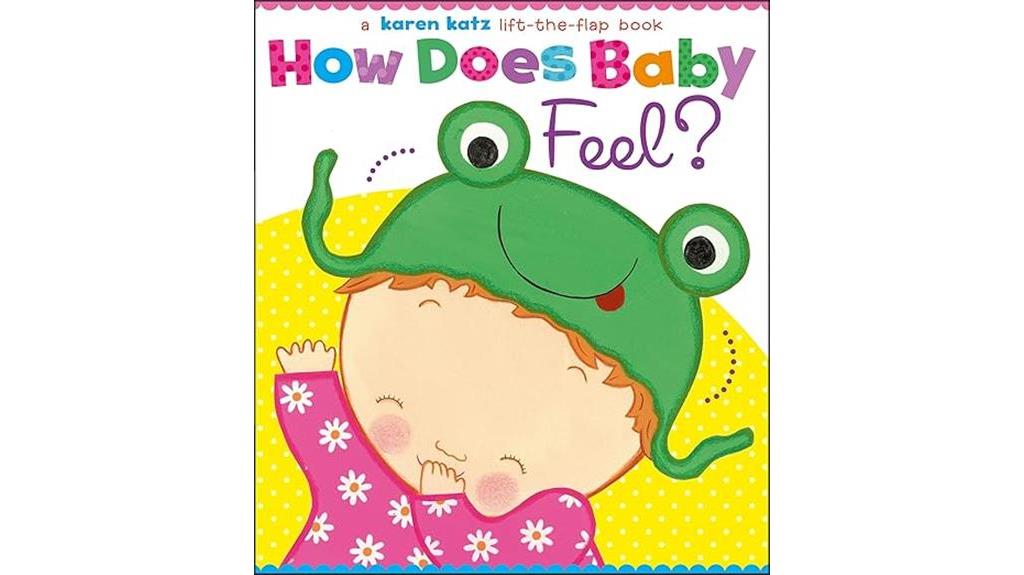
For young children aged 8 months to 2 years old, 'How Does Baby Feel?: A Karen Katz Lift-the-Flap Book' offers an engaging and interactive way to learn about various emotions through sturdy flaps and vibrant illustrations. Parents and children alike appreciate the interactive nature of the book, as children enjoy lifting the flaps to reveal different feelings depicted in the colorful illustrations.
While some users find the flaps slightly challenging for younger children, the book overall aids in language development by introducing feelings words and helping children understand emotions. This book caters to a wide range of ages within the specified group, with parents commending its educational value and ability to entertain young minds.
Additionally, suggestions for including a broader range of emotions like anger have been made, enhancing the book's potential to broaden emotional understanding.
Best For: Parents looking for an interactive and educational book to help their children aged 8 months to 2 years learn about emotions.
Pros:
- Engaging and interactive flaps that children enjoy lifting.
- Sturdy construction that can withstand toddler handling.
- Facilitates language development and emotional understanding through colorful illustrations.
Cons:
- Some users find the flaps challenging for young children to lift.
- Limited range of emotions depicted, with suggestions for including more diverse feelings.
- May not appeal to older children outside the specified age group.
A Little SPOT: My First Emotions (Inspire to Create: A Little Spot)
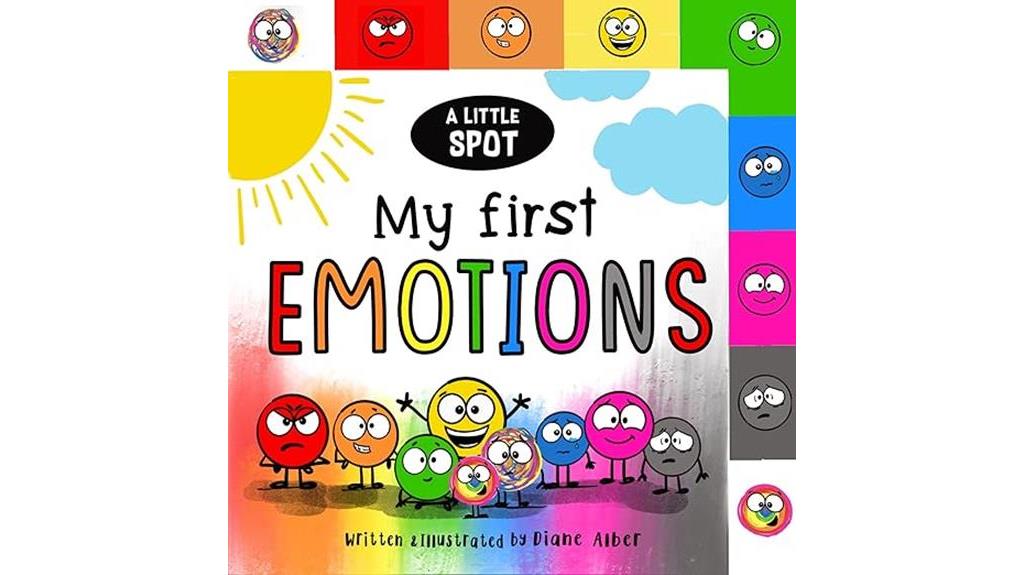
Recommended for children under five, 'A Little SPOT: My First Emotions' helps toddlers understand and express their feelings through colorful associations. This book is well-received by parents, educators, and children, offering a valuable resource for emotional development.
With a focus on helping young ones identify and manage their emotions, the book's educational value lies in its ability to introduce various feelings in an accessible manner. Through engaging illustrations and a layout perfect for toddlers, children find it easy to relate to the emotions portrayed.
To enhance interaction, readers suggest acting out the emotions with children, fostering a deeper understanding. Part of the A Little SPOT series, this book aims to assist children in recognizing and handling emotions in a healthy way, making it a valuable tool for emotional literacy in early childhood.
Best For: Parents looking to help their toddlers understand and manage their emotions through engaging and relatable storytelling.
Pros:
- Engaging illustrations that make it easy for children to relate to the emotions portrayed.
- Helpful resource for emotional development in young children.
- Encourages parents and children to interact by acting out the emotions together for a richer learning experience.
Cons:
- Some customers noted minor physical condition issues with the book.
- Limited to children under five, may not be as beneficial for older children.
- Not suitable for those looking for in-depth emotional development resources for older children.
Shady Baby Feels: A First Book of Emotions
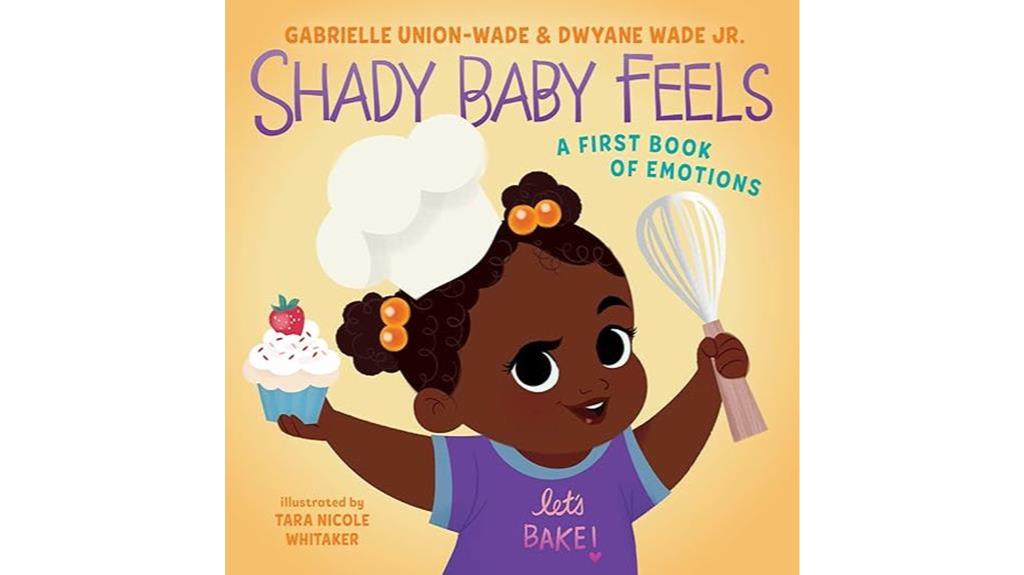
Shady Baby Feels: A First Book of Emotions is an engaging tool for fostering emotional intelligence in young children. Created by Gabrielle Union, Dwyane Wade, and Tara Nicole Whitaker, this book features Shady Baby baking cupcakes while expressing nine common emotions.
The vibrant and eye-catching illustrations make it a hit with kids, encouraging them to explore and understand their feelings in a fun and relatable way. Perfect for tiny hands with its sturdy pages, Shady Baby Feels is designed to introduce emotional literacy, self-awareness, and empathy to toddlers.
Despite some reports of minor damage upon delivery and mixed reviews on the writing style, the book is praised for its representation of diverse characters and its positive impact on early childhood mental health. Recommended for those seeking an affordable read that helps young children navigate their emotions.
Best For: Parents seeking an engaging tool to introduce emotional intelligence and empathy to young children.
Pros:
- Features vibrant and eye-catching illustrations that engage children.
- Introduces nine common emotions in a kid-friendly format.
- Promotes discussions about feelings and emotions in a relatable way.
Cons:
- Some customers reported receiving damaged copies.
- Mixed reviews on the writing style.
- Limited in-depth storytelling due to its focus on emotions.
How Do I Feel?: A little guide to my emotions (First Emotions)
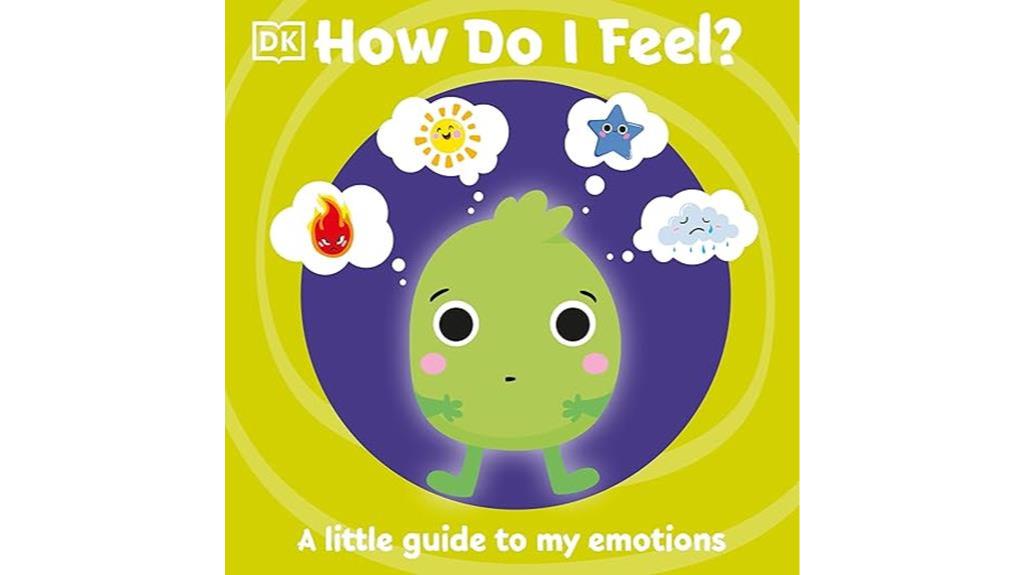
Exploring the colorful illustrations and engaging stories in 'How Do I Feel?: A little guide to my emotions (First Emotions)' is a delightful way for young children to begin understanding and expressing their feelings. This book serves as a quality introduction to emotions for preschoolers, focusing on four key emotions through easy-to-read text and engaging illustrations tailored for young minds.
By teaching children to recognize and name different emotions, it helps them understand how feelings can lead to various actions and the physical and emotional effects they may experience. Moreover, 'How Do I Feel?' encourages children to express and discuss their emotions, promoting vocabulary building and emotional development.
This book not only aids in identifying and discussing emotions but also provides a platform for children to start comprehending the complexities of their feelings.
Best For: Parents and educators looking for a simple and engaging way to introduce young children to basic emotions and encourage emotional development.
Pros:
- Quality introduction to emotions for preschoolers.
- Easy-to-read text and engaging illustrations.
- Encourages children to recognize, name, and discuss their emotions.
Cons:
- Lacks depth in explaining feelings.
- Some wording may be confusing for young children.
- May need modification for age-appropriateness.
Baby Emotions: My First Book of Emotions For Babies
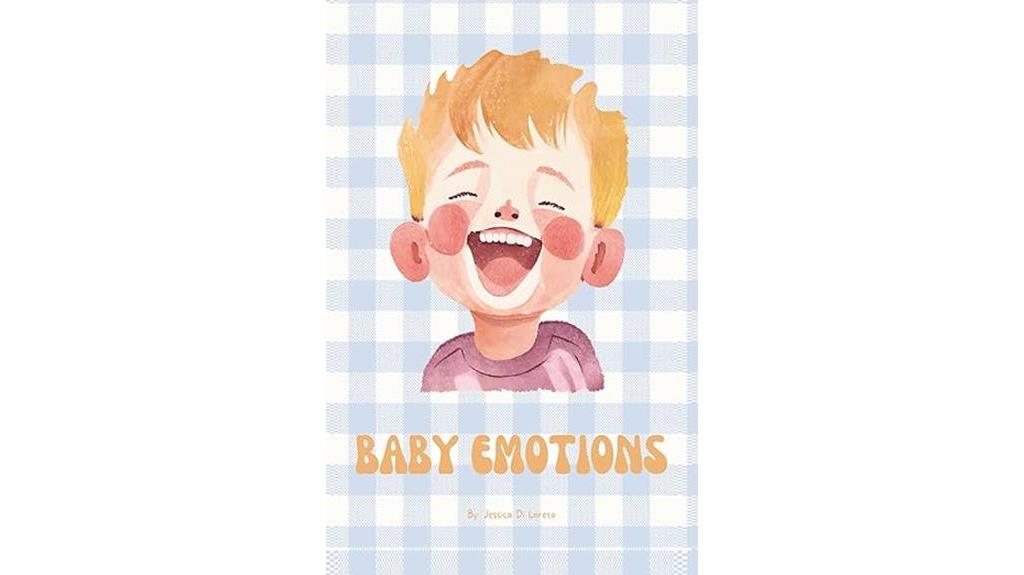
The 'Baby Emotions: My First Book of Emotions For Babies' is a valuable resource for parents seeking to introduce their infants and toddlers to a range of emotions through engaging visuals and relatable facial imagery. This charming baby book is designed to help children explore their first emotions in a fun and interactive way.
With enchanting illustrations and simple, relatable facial expressions, the book covers a spectrum of feelings from joy to sadness, surprise, and more. By providing a gentle introduction to emotional awareness, Baby Emotions aims to foster emotional intelligence from an early age.
The thoughtfully crafted design and delightful illustrations make it an engaging tool for children to learn about their emotions, while also serving as a valuable resource for parents and caregivers looking to support their little ones' emotional development.
Best For: Parents and caregivers looking to introduce their infants and toddlers to a range of emotions in a fun and interactive way.
Pros:
- Engaging visuals and relatable facial imagery
- Covers a spectrum of feelings from joy to sadness and surprise
- Fosters emotional intelligence from an early age
Cons:
- May require parental guidance for effective learning
- Limited to basic emotions, may not cover more complex feelings
- Relies heavily on visual stimuli, may not suit all learning styles
Factors to Consider When Choosing a Baby Emotions Book

When selecting a baby emotions book, it's important to take into account key selection criteria like the book's relevance to your child's age and developmental stage. Assessing interactive features and the emotional range coverage can help guarantee a well-rounded experience for your little one.
Moreover, the significance of engaging visuals can't be overstressed, as they play a vital role in capturing a child's attention and enhancing their learning process.
Key Selection Criteria
Considering the age appropriateness of a baby emotions book is vital when selecting the right one for your child. Ensuring that the content aligns with your child's developmental stage is critical for effective learning.
Look for books that offer diverse representations of emotions to foster inclusivity and a broader understanding of feelings. Interactive elements like flaps, mirrors, or textured pages can enhance your child's engagement through a multisensory learning experience.
Opt for books with clear, simple language and vibrant illustrations to captivate your child's attention and facilitate understanding. It's beneficial to choose books that cover a wide range of emotions beyond just the basics. This approach encourages a more thorough understanding of feelings and helps your child develop emotional intelligence.
Age-Appropriate Content
To choose a suitable baby emotions book, focus on the content that aligns with your child's age and introduces basic emotions in a relatable manner. Select a book that covers emotions like happy, sad, surprised, and more in a straightforward and captivating way tailored to young children's understanding.
It's crucial to make sure that the content matches your child's developmental stage to capture their interest effectively. Seek out books with clear and expressive visuals that make it simple for children to recognize and identify different feelings.
Opting for books with interactive elements or activities can also enhance your child's learning experience by encouraging them to explore and engage with the emotions being presented. By choosing a baby emotions book with age-appropriate content, you can provide your little one with a valuable tool for understanding and managing their own feelings.
Interactive Features Evaluation
I always prioritize selecting baby emotions books that feature interactive elements, such as flaps, mirrors, or touch-and-feel components, to engage children in a hands-on learning experience about different feelings.
Interactive features play a pivotal role in capturing a child's attention and encouraging active participation in understanding emotions.
When choosing a baby emotions book, it's essential to ponder if the book includes activities that prompt children to mimic facial expressions or engage in tasks related to identifying and expressing emotions.
The level of interactivity in the book should be evaluated, looking for prompts that encourage children to match emotions, make faces in a mirror, or lift flaps to reveal different expressions.
These interactive features not only make learning about feelings enjoyable and memorable for young children but also contribute to their emotional development by providing tangible experiences that enhance their comprehension of various emotions.
Emotional Range Coverage
Exploring the emotional range covered by a baby emotions book is important when selecting the right one for young children. It's necessary to consider whether the book encompasses a wide variety of emotions, ranging from basic ones like happiness and sadness to more intricate feelings such as surprise and fear.
Look for books that introduce emotions clearly and in a relatable manner for babies and toddlers to grasp and connect with effectively. Ensure that the book addresses key emotions important for early emotional development, including joy, anger, fear, and love.
Check if the book aids children in identifying and expressing a diverse range of emotions through engaging visuals and simple descriptions. Opt for books that offer a thorough overview of different emotions, enabling children to learn about and process their feelings efficiently.
Engaging Visuals Importance
Engaging visuals play an integral role in selecting a baby emotions book. They are important for capturing a baby's attention and facilitating their emotional learning journey. Bright colors, expressive facial images, and simple designs are key elements that can help babies recognize and connect with different emotions effectively.
Visual cues are significant in aiding babies to understand and respond to the various feelings they encounter during their developmental stages. Incorporating interactive elements such as flaps, mirrors, and touch-and-feel textures can further enhance the visual experience, promoting engagement and sensory exploration.
It's vital to choose age-appropriate visuals that are clear, bold, and relatable to make sure that babies can grasp the concept of emotions proficiently. By selecting books with engaging visuals that align with a baby's cognitive development, caregivers can actively support their little ones in navigating the intricate world of emotions.
Parental Guidance Role
When selecting a baby emotions book, parents should consider various factors that can enhance their child's emotional learning journey. Parents play a vital role in guiding their children through understanding feelings by providing support, empathy, and modeling positive expression of emotions. By engaging in open conversations about emotions, validating their child's feelings, and teaching healthy coping strategies, parents can help children manage and express their emotions effectively.
Creating a safe and nurturing environment at home is essential for children to explore and comprehend a wide range of emotions. Utilizing books, activities, and everyday experiences can aid parents in helping children identify, label, and regulate their emotions. Hence, parents should choose baby emotions books that align with their parenting style and values, offering content that facilitates discussions about feelings and provides tools for emotional development.
Educational Value Assessment
I consider various factors when choosing a baby feelings book for my child to ensure it promotes emotional learning effectively. One important aspect is evaluating the book's ability to introduce and teach basic emotions like joy, sorrow, and astonishment to babies and toddlers. It's vital to assess how the book encourages interactive learning by prompting children to imitate facial expressions and recognize emotions, fostering engagement and understanding.
Age appropriateness is another significant factor, guaranteeing that the content is suitable for children aged 1 to 5 years old to understand and engage with effectively. Additionally, examining how the book aids in cultivating emotional intelligence in young children by assisting them in identifying and expressing their feelings is crucial.
Besides, considering how the book's content and design contribute to a child's emotional learning journey, providing a foundation for understanding and managing emotions, is necessary for a thorough emotional development. By taking into account these factors, I can choose a baby feelings book that offers valuable educational benefits for my child's emotional growth.
Frequently Asked Questions
How Can I Help My Baby Express Their Emotions Effectively?
I help my baby express emotions by acknowledging their feelings, providing a safe environment for expression, and using simple language to label emotions. I offer comfort and support, encouraging healthy emotional development.
Are These Books Suitable for Babies With Sensory Sensitivities?
Around 20% of babies have sensory sensitivities. While these books may be helpful for some, it's important to take into account individual needs. I suggest consulting a pediatrician or child development specialist for tailored recommendations.
Can Reading These Books Help Babies Develop Empathy?
Reading these books can nurture empathy in babies by exposing them to various emotions. Through colorful illustrations and simple stories, babies can begin to understand and recognize feelings, fostering a sense of compassion and understanding.
Do These Books Include Interactive Elements for Sensory Exploration?
They engage babies with textured pages, peek-a-boo flaps, and sound buttons for sensory exploration. The interactive elements enhance their learning experience and make understanding feelings more fun and engaging.
Are There Any Tips for Parents on Using These Books to Teach Emotions Effectively?
I find that using these books as conversation starters is key. Ask open-ended questions, relate stories to real-life experiences, and mirror emotions with facial expressions. Encourage empathy and validate feelings to enhance emotional learning.
Conclusion
To sum up, exploring baby emotions through books can help little ones understand and navigate their feelings as they grow.
Remember, 'A picture is worth a thousand words,' and these baby emotions books are filled with vibrant illustrations and simple language to engage young minds.
By introducing these books early on, parents can assist in building emotional intelligence and communication skills in their children, setting a strong foundation for healthy emotional development.
-

 Parenting Styles3 months ago
Parenting Styles3 months agoCultural Differences: American Parenting Vs Chinese Parenting
-

 Parenting Styles3 months ago
Parenting Styles3 months agoWorst Parenting Style: Impact on Child Development
-
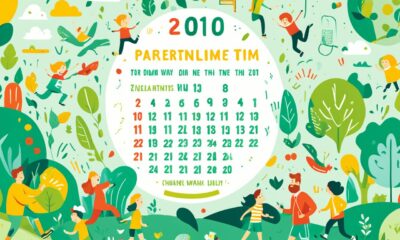
 Parenting Styles3 months ago
Parenting Styles3 months ago2023 Indiana Parenting Time Guidelines Update
-

 Vetted3 months ago
Vetted3 months ago15 Best Parenting Books of All Time Every Parent Should Read
-

 Education3 months ago
Education3 months agoFoster Parent Pay in the US: Unveil Earnings
-

 Education3 months ago
Education3 months agoEmpowering Parents Through Digital Education Guide
-

 Vetted3 months ago
Vetted3 months ago15 Best Co-Parenting Books Every Parent Should Read for Successful Co-Parenting
-

 Vetted3 months ago
Vetted3 months ago15 Best Books on Step Parenting Every Blended Family Needs to Read
